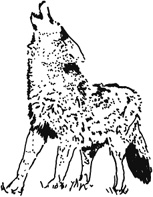
Greg Davenport
Illustration by Steven A. Davenport
DESCRIPTION
The gray wolf is a four-footed carnivore that ranges in size from 55 to 150 pounds and stands approximately 26 to 32 inches at the shoulder. Gray wolves are found in Alaska, Idaho, Michigan, Minnesota, Montana, Wisconsin, and Wyoming, as well as Canada, Europe, Asia, the Middle East, and Russia. They are primarily located in forests, tundra, deserts, plains, and mountains. The wolf’s diet mainly consists of large, hoofed mammals, such as deer and elk, though on occasion they also prey on smaller animals, such as beavers or rabbits.

Gray wolf.
WHAT YOU SHOULD KNOW
Encounters with wolves are infrequent, and wolves do not naturally behave aggressively toward humans. Wolves live in packs, which include a dominant alpha male and female, along with their offspring, and they communicate by scent marking, vocalizing, facial expressions, and body postures.
ONCE YOU GO
To avoid sudden encounters, stay on well-established trails, be aware of your surroundings, and avoid hiking alone or at dawn and dusk, when wolves are most active. If you have children with you, keep them close by. Do not let them wander off-trail or into the wilderness. Wolves are generally shy and timid, and the likelihood of an attack is extremely remote.
—From Surviving Cold Weather
Greg Davenport
Illustration by Steven A. Davenport
DESCRIPTION
Moose are four-footed vegetarians that can weigh as much as 1,600 pounds and stand as tall as 6.5 feet at the shoulder. They are found in the northern United States, Canada, Europe, and Asia, usually in forested areas. A moose’s diet primarily consists of new tree growth (aspen, poplar, willow, birch, dogwood, and balsam fir) and underwater vegetation. Although moose can run fast, a large percentage of yearlings fall prey to wolves and bears.
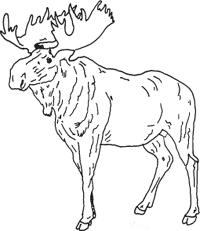
Moose.
WHAT YOU SHOULD KNOW
Moose are generally solitary animals and are not normally aggressive toward humans. The rare moose attack occurs during mating season, when the animal believes its calf or food is threatened, it is tired of walking in deep snow, or it is being harassed by people.
ONCE YOU GO
To avoid sudden encounters, stay on well-established trails, and be aware of your surroundings. Should you encounter a moose and it begins walking toward you, stay calm, back away, and look for a tree or other object to put between you and the animal. Like brown bears, moose will often do a bluff charge. Unlike your behavior with the bear, however, you should run and look for a tree or other obstacle to get between you and a charging moose. If a moose should knock you down, curl up into a fetal position, and use your arms and hands to protect your neck and head. Do not move until the moose has left and is a safe distance away from you.
—From Surviving Cold Weather
Elizabeth P. Lawler
Illustrations by Pat Archer
(Mephitis mephitis)
Although skunks are considered nocturnal animals, they often begin foraging during the late afternoon or early evening hours. They have a fine sense of smell and very good hearing, important since they hunt at night. Striped skunks are nearsighted, however, which makes it relatively easy for us to get close to them. If you move quietly and slowly toward a grazing skunk, you can usually get within ten feet of it without disturbing it. If this makes you nervous, you can make accurate observations from as far away as twenty feet. The skunk will use its warning system to tell you if you get too close. Remember, the skunk does not want to spray you, so back away when you see it raise its tail. …

The striped skunk (Mephitis mephitis,) assumes its infamous U posture before spraying musk.
Daytime Skunks.
Although skunks are generally nocturnal, you may find one foraging during the day, especially during warm winter days. You also can expect to see newly weaned skunks foraging in cornfields, hay fields, pastures, fencerows, and along waterways in daylight. Although nocturnal animals that have the disease rabies are often seen out of their dens during the day, they usually exhibit more than one behavioral abnormality such as aggression toward other animals. If unusual behavior raises questions about the health of a particular skunk, call a wildlife specialist. Do not harm the skunk or approach it. …
Voice. Skunks are quiet animals. They hunt and play in silence, although when a fight breaks out between two skunks you will hear a barrage of growls, squeals, and hisses. When foraging or when tending their pups, you may hear soft grunts, growls, barks, and churrings. Snarls and twitters that resemble those made by birds and squirrels are also in the skunk vocabulary. …
The Warning. It is well known that skunks will not discharge a blast of musk without ample warning, so it is a good idea to learn how to recognize it. An unconcerned, relaxed striped skunk ambles along with its tail nearly touching the ground. As the first signal in the warning system the skunk may stamp its front feet. It does this rapidly and loudly enough that you can hear it several yards away. You may also hear growls or hissing sounds at this time. Many skunks omit this first step and proceed directly to the tail-raising signal. In this stage the major portion of the tail is held erect, but the tip may flop over to one side. The long guard hairs along the entire length of the tail stick out at right angles to it. This makes the tail look extremely large. Immediately before musking, the skunk assumes its infamous U posture, at which time its head and tail directly face the intruder. If you are still considered a threat at this point, the skunk will probably spray you.
Myths. Like other creatures of the night, many myths surround the lives and habits of skunks. Following is a list of some of them:
• Musk can damage your eyes. The truth is that although musk can cause intense burning, it does not cause permanent damage to the eyes.
• Skunks spray musk with their tails. Scientists know that they spray with nipples that are connected to anal sacs.
• Musk is made of urine. Musk has its own chemical composition that is very different from skunk urine.
• Skunks are aggressive. They are not. They are among the peaceable animals in the forest. …
(Spilogale putorius).
This little skunk is smaller than its cousin the striped skunk. Its weight ranges from a mere three-fourths of a pound to two and three-fourths pounds, and its total length can be from about fourteen inches to twenty-two inches. Generally, the spotted skunk doesn’t venture from its den until after nightfall, and it is more secretive than the striped skunk. …
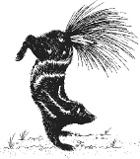
The spotted skunk performs its famous handstand before musking.
Alarm Display. The spotted skunk has a fascinating alarm display. Like the striped skunk, its gives its first warning by stamping its feet and then raising its tail. If these signs do not deter the intruder, the spotted skunk displays its famous handstand. When raised up on its two front feet it looks larger than it really is, and its agility in this position rivals that of a high-wire performer. There is no doubt that the spotted skunk can spray in this position; it does not have to have four feet on the ground in order to do so. …
Antidote for Musk. There are as many antidotes for removing skunk musk as there are people who have been sprayed by it. One large can of tomato juice, perhaps two, is usually sufficient to neutralize the musk sprayed on one small boy and a dog.
Although it may seem inconceivable for those who find the smell of skunk musk offensive, there are those who find the odor quite pleasant, at least in small doses. The tolerance for this odor appears to be genetic.
—Excerpted from Discover Nature at Sundown
Elizabeth P. Lawlor
Illustrations by Pat Archer
Bats are mammals. They have body hair and mammary glands and give birth to live young, but unlike any other mammal, bats can fly. Their “hand” and forearm bones are similar to those found in other mammals but they are adapted to accommodate the bat’s continuous wing membranes. This thin, double layer of skin encloses its somewhat elongated forearm; long, tapered fingers; and hind limbs. In some bat species, the tail is also enclosed by this membrane. A bat’s fingers have great dexterity, so they can manipulate the wings to form umbrella shapes that trap insects, as well as hover in midair like hummingbirds. In all species of bats, the clawlike thumbs of their extraordinary hands remain free outside the wing. Bats use this fine tool for clinging to the walls of caves, hanging from tree branches, and manipulating food and other objects. The wings are designed so that a bat can fold them close along its side like a collapsed umbrella. This feature lets the bat crawl along a flat surface without getting tangled in folds of skin.
Bats belong to the order Chiroptera, which comes from the Greek word chiro, meaning “hand,” and petra, meaning “wing,” references to the unique structure of the “hand-wing.” Bats come in a variety of sizes and colors including dark brown, orange, yellow-gray, black, red, gray, and white. Bats have adapted to such a variety of climates that you can find them anywhere in the world except in the polar regions. A few red bats (Lasiurus borealis) have been found as far north as Southampton Island in the Canadian Arctic, but most species of bats live in the tropics because food is available there year-round.
The order Chiroptera is divided into two groups: large bats, or megabats (Megachiroptera), and small bats, or microbats (Microchiroptera). Megabats, often called flying foxes because of their foxlike faces, live in the tropics of Africa, Australia, and Asia and have wingspans up to six feet. Unlike their smaller relatives, many megabats are active during daylight hours and have large eyes and good vision. This feature, coupled with their finely tuned sense of smell, leads them to nutrient-rich flowers and ripe fruits, the staples of their diet. Their pointed, doglike snouts and long tongues allow them to reach into flowers for protein-rich pollen and sweet nectar, pollinating the flowers in the process. Some bats also help propagate tropical plants by eating their fruit and later depositing the seeds some distance from the parent. Bats in some regions of the world feed on fish, lizards, and mice, and the vampire bat that lives in the tropics eats the blood of cattle. This preference for blood has led the bat to occasionally inflict a pinprick wound in humans and has contributed to the superstition that all bats drink blood.
The smallest microbat is the bumblebee bat of Thailand, which weighs less than an average paper clip. All of the bats that live in the United States and Canada are microbats. These bats spend the day in dark places and hunt for food—usually flying insects—at night. Filling this nighttime niche permits them to be active when most predatory animals are at rest. Microbats do not see well in dim light, but their well-designed sonar systems more than compensate for that deficit. With this tracking capability, called echolocation, a bat can determine the size and shape of an object, how far away it is, and whether it is moving. To do this, the bat emits a stream of high-pitched clicks and squeaks that are inaudible to humans. When the sound waves hit an obstacle, they are returned to the bat as an echo. The bat “reads” the echo and acts accordingly. You can observe this sonar system at work if you watch a bat rapidly fly through a grove of trees. It never hits a single branch or twig as it pursues its next meal. The sending of the pulses and their return as echoes happens in a fraction of a second. We can hear sounds that are within the range of 20 to 20,000 cycles per second, or hertz. The pulses produced by bats are above 20,000 Hz (also expressed as 20 kilohertz or 20 KHz).
Only microbats echolocate by producing the high-frequency tones in the larynx. Some echolocation calls, such as those of the North American Nyctinomoas, are audible to humans, but most of the gentle squeaks we hear are not the vibrations of the tracking system but communication among the bats. One species of macrobat produces high-frequency calls with its tongue, a more primitive form of echolocation than the laryngeal technique of the microbats. Leafnose bats, of which four species live in North America, release sound from megaphone-shaped mouths or queer-looking folds of skin on their noses.
Most microbats have a spearlike growth called the tragus that stands upright inside each ear. The tragus is somehow part of the echolocation system, but scientists have yet to discover its exact function. Ridges inside the fleshy part of the bat’s ear are also part of the sonar system. Echolocation is an advanced strategy for navigating and hunting in the dark shared by dolphins, whales, some shrews, and a few species of South American birds.
Throughout the warm months of spring and summer, insect populations explode. As the numbers of these pests increase, so do the numbers of electric bug zappers in suburban neighborhoods. This human invention can’t equal the work of bats, however. Scientists have estimated that a little brown bat (Myotis lucifugus) eats at least one-third of its body weight in insects in a half hour of foraging. At this rate, a population of Mexican freetail bats in Texas would eat 12,000 tons of insects per night. The insect diet of North American bats makes them our most important allies in insect control.
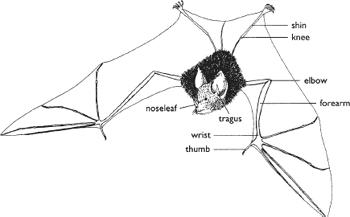
Basic anatomy of a bat.
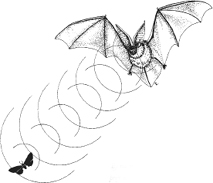
By means of echolocation, bats can find prey even on very dark nights.
As summer fades into autumn, the supply of insects begins to dwindle and the nights grow cool. Soon freezing temperatures will cover the ponds with ice and the land will be in winter’s grip. So in July, some species of microbats begin migrating to the warmer latitudes of Central and South America. By August, most migratory bats are on the move. Some species of bats that spend the summer in Canada and the northern United States migrate to certain areas of the American South to hibernate. The Mexican freetail bats migrate to Mexico and Central America, where they remain active. …
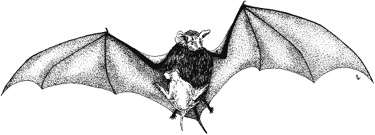
A joung Mexican freetail bat (Tadarida brasiliensis) is carried by its mother.
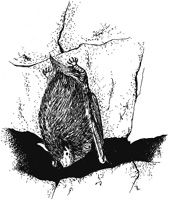
The little brown bat (Myotis lucifugus) is one of America’s most abundant bats.
During the warmer months, many bats use their winter hibernation caves as daytime roosts. They leave these roots at dusk to feed on night-flying insects and to drink by skimming water surfaces while flying. A colony of Mexican free-tail bats leaving a cave often looks like a huge, black cloud; observers frequently compare the emerging bats to the whirling spiral of a tornado. Other bat species are solitary and may roost in tree hollows or hang upside down from branches. Bats in this position often resemble dead leaves or are camouflaged by the foliage. Solitary bats sometimes find the space behind window shutters or under loose tree bark to their liking. They look for a snug spot that is secluded and dark. …
Bats are not dangerous, but when you find one leave it alone. Your touch might startle it and it may respond like any other frightened animal by snarling, biting, and scratching. Scientists who study bats usually wear heavy work gloves when handling bats.
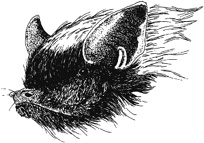
Silver-haired bat.
(Lasionycteris noctivagans)
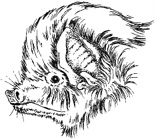
Red bat.
(Lasiurus borealis)
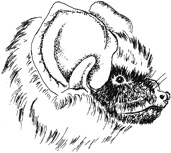
Hoary bat.
(Lasiurus cinereus)
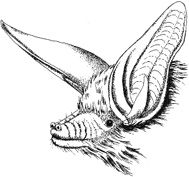
Pallid bat.
(Antrozous pallidus)
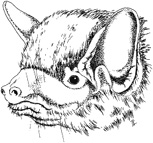
Evening bat.
(Nycticeius humeralis)
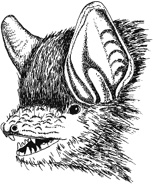
Big brown bat.
(Eptesicus fuscus)
Except for the nectar-drinking, pollen-eating long-nosed bats (Leptonycteris) of the southwestern United States, which forage during the day, most North American bats wait until twilight to begin hunting for insects. Although large roosts are easier to find than small ones, locating any of these daytime hangouts can be very difficult. Some species of bats gather in rock crevices where they are protected from the burning rays of the summer sun. Others snuggle in the crannies of bell towers or attics, and still others prefer to dangle from barn rafters. Sometimes bats like to recuperate from a night of hunting in the close spaces behind window shutters. The big brown bat (Eptesicus fuscus), also known as the house bat, is especially fond of shelter.
Bats that roost in churches, houses, barns, and other buildings generally give away their presence by a brown stain caused by their droppings running down the side of the building. Another sign of bats is the whitish guano that collects on the ground below a roost. If you are a patient and persistent observer, you may discover some bat roosts in your community. Another good way to locate bats is to ask a naturalist at a nature center about local bat populations. Some of the North American bats that prefer group living and congregate in buildings are the evening bat (Nycticeius humeralis), the big brown bat, the little brown bat, and the pallid bat (Antrozous pallidus). Although the Mexican freetail bat (Tadarida brasiliensis) gathers in huge colonies, it prefers to assemble in caves rather than in buildings.
Communal living is not for all bats. Some bats shun both buildings and caves and seek the solitude offered by a hollow tree, or simply hang from tree branches. Asleep in the cool shadows of the foliage, these bats usually go unnoticed because they resemble dead leaves. Young bats, still hugging their mothers, also find safety in trees. Hunting for solitary bats can exhaust the patience of the most skilled field worker. The eastern pipistrel (Pipistrellus subflavus), the most abundant bat in the eastern United States, prefers to roost in sycamore trees, but they’re extremely difficult to find. The red bat, the silver-haired bat, and the hoary bat (Lasiurus cinereus) also like to hide in trees and shrubs.
Many people who live in or visit the southwestern United States know that millions of Mexican freetail bats roost in the caves of Texas and New Mexico, where they are featured as a tourist attraction. Unlike most bats that live in the eastern part of the United States, western bats generally roost in caves and deserted mines.
Listed below are some of the bats you are likely to find in and around your community. Although these are the bats we see most often, little is known about their habits and their haunts.
Little brown bats. Widely distributed across the United States and Canada, this is our most abundant bat, often found with the big brown bat. Look for it in buildings, behind shingles or siding, or in attics.
Big brown bats. These bats range from Alaska and Canada south through the United States into Mexico. Their roosts include attics, barns, and other buildings; behind window shutters; in expansion joints beneath bridges; and occasionally in tree hollows. These bats hang around with the mouse-eared bats such as the little brown bat and its western cousin Yuma myotis (Myotis yuma-nensis). You also can find it with the Mexican freetail bat, with the pallid bat, and in close association with people.
Evening bat. Found from Pennsylvania south to the Gulf Coast, this bat avoids caves but prefers buildings, where large nursing colonies are often found. Smaller groups of these bats will roost behind tree bark or in tree hollows. It commonly roosts with the Mexican freetail bat.
Mexican freetail bats. On the West Coast and in the Southeast, this bat prefers to roost in buildings. In Texas, Arizona, Oklahoma, and New Mexico, however, its preference for caves is well known by visitors and locals. Because these bats have been studied so extensively, we probably know more about them than any other kind of bat. They share buildings in the West with the pallid bat, the big brown bat, and the Yuma myotis. In the Southeast you can find them with southeastern myotis (Myotis austroriparius) and the evening bat.
Pallid bat. These desert bats of the Southwest prefer rocky ledges and outcroppings where scrub vegetation such as mesquite grows. They are also found in Oregon and Washington, and a few colonies flourish in southern Kansas and Oklahoma.
The remaining bats prefer to spend the day in trees, and because of their solitary nature, they are extremely difficult to find.
Hoary bat. The most widespread of North American bats, the hoary bat is not yet found in Alaska. Its capture in the mist nets of bat banders suggests that there may be more of these rare bats than previously thought. This bat spends its days hidden in tree foliage, where it can be well concealed from above but have enough open space in the foliage below that it can drop down and begin its flight.
Red bat. Ranging from southern Canada and the eastern United States into Mexico and Central America, this tree-roosting bat prefers to hide beneath the leaves of sycamore trees, although the lush foliage of any board-leaved tree will suffice. Infrequently they dangle like dead leaves from a branch or twig. Female bats roost with their young.
Silver-haired bat. Found primarily in the North but appearing in all states except Florida, these bats spend their days roosting behind loose tree bark or in abandoned woodpecker holes or bird nests. Sometimes they find solitude in outbuildings such as tool sheds and garages. Infrequently they have been found in small nursing groups. …
Although an occasional bat can be found flying about during the day, most bats take to the sky during the twilight hours. On a summer evening you can observe them in a dance of twists, spirals, and loops that is choreographed by the insects they pursue. Although it’s difficult to identify a flying bat, the following are some points to keep in mind as you make your observations.
Describe its flight path. Is it straight and steady? Is is circular? Describe the habitat. Is there water nearby? Is the bat flying over a pasture? Was it flying close to the treetops? Did the bat spend most of its flying time higher or lower than the trees? Was it flying over a lawn or around lampposts? Was it alone, or were other bats flying nearby?
The following focuses on the flight pattern, wingspans, flight patterns, and foraging habits of the bats you will most likely see. Keep a record of bat sightings. Don’t forget to include the date and time of your observations in your field notebook.
Little brown bat. A medium-sized bat with a wingspan of about eight inches (222–269 mm.), this mouse-eared bats prefers to forage over water, but if none is available it will hunt for food over pastures and lawns and among trees. They fly their zigzag flight ten to twenty feet above the ground. Look for their foraging pattern, which is often a repeated circular path around a cluster of houses or trees and often includes the entrance to their roost.
Big brown bat. A large bat with a wingspan of thirteen inches (325–350 mm.), this is the most familiar bat of the summer night. It begins foraging at dusk and flies in a steady, somewhat straight path about twenty to thirty feet above the ground. A big brown bat’s flight pattern is often broken as it zips off course to capture insects. In a pattern similar to that of other kinds of bats, big brown bats fly over and over the same path each night. If you become familiar with some of these feeding paths, you will probably see the same bat flying there each night. These bats frequently are seen flying around the lights that line city streets.
Evening bats. The wingspan of these small bats is about ten inches (260–280 mm.). They begin foraging early in the evening and are plentiful around southern communities. Their slow flight and steady course make them easy to recognize after you have had some experience observing bats in flight. Not much is known about the feeding habits or the seasonal movements of these bats.
Mexican freetail bats. The span of their narrow wings is about eleven inches (290–325 mm.). When they leave their caves in Texas and New Mexico about fifteen minutes after sunset, they form a huge black cloud in the sky, and a roar like that of rushing water accompanies their departure from the roost. The flight is spectacular. Soon after leaving the cave, the bats go off in separate directions. These colonies are so large that some bats are just leaving as the first to exit begin to reenter the cave. They feed on small moths.
Pallid bat. Its wingspan is about fifteen inches (360–390 mm.), and it flies low, about three or four feet above the ground as it forages. Unlike other bats, these large-eyed bats hunt the ground for beetles and other insects.
Hoary bat. This is a large bat with a wingspan of about sixteen inches (380–410 mm.). Look for their straight and fast flight as they emerge late in the evening. Little is known about the eating habits of these attractive bats.
Red bat. The long, pointed wings that span about eleven inches (290–332 mm.) and its long tail in silhouette against the darkening sky are clues that you may be seeing this lovely reddish orange bat. These fast fliers have been clocked at forty miles per hour. When foraging, they fly low over treetops but will frequently hunt only a few feet above the ground. Red bats look for flies, true bugs, beetles, cicadas, and crickets. Although not much is known about their diets, the few known food preferences lead scientists to believe the little red bat hunts for some of its food on the ground. Not much is known about their habits.
Silver-haired bat. This medium-sized bat has a wingspan of about ten inches (270–310 mm.). Its flight is leisurely, and it cruises close to the ground and not above twenty feet. These bats may appear singly but are frequently found foraging in pairs. Because they are so difficult to find during the day, these bats, like so many others, have not been studied extensively, and most of their habits remain a mystery.
Although swallows are active during the day, you may see them in the twilight as they skim the surfaces of ponds and streams. At this time, they are often mistaken for bats.
Common nighthawks (Chordeiles minor) are adept at catching insects while in flight. These avian fliers lead reclusive lives during the day but appear in the night sky in search of insects. These birds forage over open country, but you may see their silhouettes against the night sky in cities and towns. Scientists have found that bats and birds feast on caddisflies (trichopterans) and other insects, whereas both avoid midges (chironomids).
Whippoorwills feed extensively on moths and other insects caught on the wing. You may see these nightjars flying over woodlands that are close to open fields. When caught in the beam of automobile headlights, the birds’ eyes reflect ruby red. Chuck-will’s-widow flies over fields and low to the ground in its hunt for beetles, moths, winged ants, and termites. Look for these competitors in the evening sky.
With the help of the silhouettes below, try to identify the nighthawk, whippoorwill, and swallow while in flight. Compare their flight patterns with those of bats. Which of these night fliers do you think is most agile?

swallow

whippoorwill

nighthawk
Occasionally bats get into squabbles with one another. Although these confrontations are seldom serious, bats have been known to die as a result of them. If you should find a pair of battling bats, observe the strategies each uses to outwit the other. How do they use their arms? Do they make any noise?
Most scientists believe that hanging upside down lets bats use spaces not inhabited by other animals, such as cave ceilings, undersides of tree limbs, and rock crevices. It may be an adaptation that protects them from predators.
Bats don’t really want to tangle with you or your hair. How close do you predict a bat will come to you before veering off? To find out, you will need some courage and a friend to help you. When you see a bat coming in your direction, remain still. Your friend can observe the flying bat to determine how close it gets. Try it again. Why do you think the bat doesn’t hit you?
—Excerpted from Discover Nature at Sundown
Kurt Rinehart
Lots of great birders take their guides with them into the field, but I’m more of a general naturalist than a dyed-in-the-wool birder. Faced with the prospect of taking six or more guides with me into the field, I choose to take none. In the field I concentrate on observations, often taking notes on a small pad. This forces me to spend lots of time with the books at home. Ultimately, spending time paging through your guides and imagining encounters with those birds are the best things you can do to improve your birding skills.
I recommend that you start birding without binoculars. At first, you just need to be able to spot birds—birds that quietly sneak off into the brush or zip into distant trees as you approach. The more birds you see, the more you will identify, so try to see lots of birds. Once you start to get the hang of seeing the birds, begin noticing the landscape and the birds’ behaviors. Keep your mind and your eyes wide open to changes in habitat; see where the birds are within the habitat and how they act. Spend some time, wherever you are, observing bird behavior. My memories of watching House Sparrow mothers feed their fledgling young at a bus stop in New Jersey are just as precious as my memory of going to that one magical spot glimpse some exotic species and check it off my list. Due attention to the familiar will build your skills and usher in new mysteries.
There is a park in Southern California that I used to visit almost every day when I was really learning my birds. I had been interested in natural history for a while, but I was channeling a lot of energy into building my skills as a naturalist. Let’s suppose that you are walking through this park along the Creek Trail, which runs along a small creek in a wooded ravine. The trail starts off open to your right, but ahead the trees close in and cover both sides of the trail.
As you near the oak canopy, you see a couple of birds up ahead. Both are on the ground in the shadows. One is to the left of the trail near some trees and brush, and the other is a little deeper in the woods under the trees to the right. You stop when you see them and watch for a few moments. You want to get a better look, but as you approach, they both fly away. All you could see for sure was that they were both medium sized, about the size of a robin, and both brown. The shadows made it hard to tell, but neither had any obvious or bold markings. You’re pretty sure that they were two different species, however, because one seemed to have a longer tail and was a little lighter color than the other.
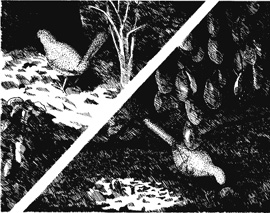
The birds are partly obscured by distance, shade, and vegetation.
In the moment that you see a bird, you strive to observe all you can, but there is often little time. Sometimes there are obvious details of appearance that make identification easy, but it takes practice to see them. In this case, you didn’t see anything that would distinguish one bird from another. Given that you saw little of the two birds’ plumage and field marks, even if you could find some possible matches by flipping through every page in your field guide, you still couldn’t be confident of an identification. There will always be sightings that stump you or leave you feeling a little confused, but let’s look at this situation again. Was it really so ambiguous? What else could you have noticed?
It’s important to notice where the birds are within the habitat, or the natural setting where they live. I call this location within the habitat the “microhabitat.” With birds, this generally refers to where they are in relation to the ground and what they are perching on. Since they can fly, birds’ microhab-itat can be anywhere from on the ground to thousands of feet up in the air.
Most birds are observed when they are foraging, so we can assume that both the birds you saw are ground feeders, but they were doing so differently. The first bird scratched in the leaves with its feet. It used an odd double-scratch technique, like short foot-dragging hops backward. The other bird scooted along by running, one foot in front of the other, intermittently picking through the leaves with its beak. The manner of the first bird was what I call high-strung; its movements were sharp and jerky. The other bird was more fluid, almost sneaky. The posture of the two birds was similar, generally stooped forward. But the first bird held its tail and often its head up a bit, whereas the second bird’s tail was angled down and it kept its head hunched down, at least while it was looking for food.
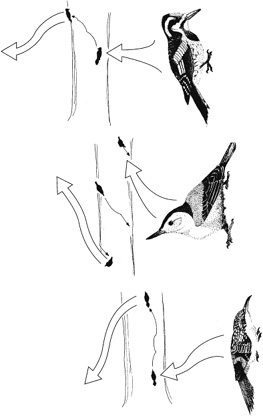
Microhabitat and behavior clearly identify woodpeckers, nuthatches, and creepers as trunk feeders. Broad arrows show flight paths. Small arrows show trunk foraging paths.
This may seem like too much to have noticed with such a brief glimpse, but the more you practice paying attention, the more you’ll see. But how is this useful? You can’t look up behavior in a field guide. The point is, behavior can provide other information that will help identify these birds from a book.
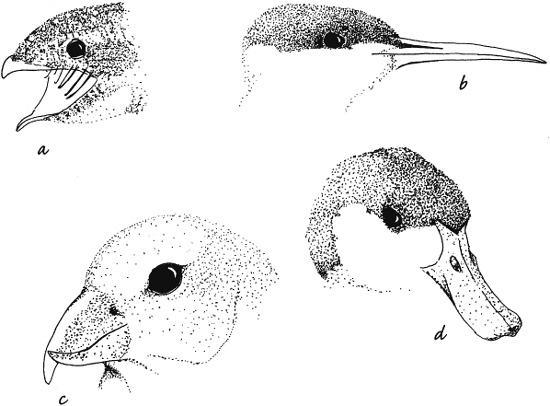
Bills for eating insects on the wing (a), diving on fish (b), opening conifer cones (c), and dabbling in pond mud (d).
For instance, we are guessing that these birds are ground feeders based on microhabitat and behavior. Microhabitats are not random; they depend on where these birds have to be to find the right food. For instance, only a few types of birds have the traits necessary to make their livings on the trunks of trees. Each has a particular mix of physical form and behavior that allows it to exploit tree trunks for survival. Woodpeckers have pecking bills; strong, grasping feet; and stiff tails that act like kickstands, allowing them to support themselves on tree trunks and limbs and dig out insects for food. Nuthatches and creepers also feed on trunks and have their own unique traits that allow them to do so. So any bird on a tree trunk is a woodpecker, a nuthatch, or a creeper. The behavior of these three kinds of birds allows you to distinguish among them at great distances. Woodpeckers feed head-up, working their way upward as they go. Nuthatches feed head-down and work their way from the tops of trees to the bottoms. Creepers work their way upward but move stealthily, hugging the tree closely, whereas woodpeckers jut out and move about noticeably. The human eye registers movement and form before it registers color, so by the time you see the plumage, your job is narrowed down to identifying the species of woodpecker, creeper, or nuthatch. Since we have a sense of what is available to eat on the ground here—seeds and invertebrates—we should be able to make some guesses about the birds’ beaks. The beak is the primary tool for foraging. It has other functions, such as grooming feathers, but feeding ecology has a major influence on the form of the beak. Even though both birds you saw are ground feeders, I would guess that they have different beaks based on their different foraging behaviors.
Woodpecker beaks are stout, straight, and sharp for pecking into wood. Nuthatches have fine, straight, sharp bills that are good for picking insects and spiders from bark crevices and are capable of hacking into tough seeds and nuts. Creepers move slowly up trees and limbs using their fine, downward-curving bills to pluck bugs from the bark. In addition to insect-eating bills like these, there are beaks designed for eating every other kind of available food.
Suppose you were a bird picking through leaves to find your food. Would you want a long beak or a short beak? Consider the people who pick up trash in parks and on roadsides. They usually carry a pincerlike grabber with a 3-foot handle. Imagine trying to pick up trash with a pair of pliers. If you had to use pliers, you might change your tactics. Maybe instead of picking up each piece of trash individually, you would kick a bunch of it together in a pile and then pick it up all at once.
These birds (their ancestors, actually) have had to grapple with these same issues of effort and efficiency. Because of this, I would guess that the bird picking through the debris with its beak has a longer beak than the other bird. But why would a bird feeding in debris have a short beak at all? The answer has to do with leverage. A 3-foot-long trash grabber is good for picking up litter, but I would rather have pliers for loosening a nut on my car—or for cracking a nut, for that matter. Many ground-feeding birds that eat seeds have short, stout bills like pliers that allow them to crack or husk hard seeds. If your preferred food was seeds, you wood be better off with a stout, seed-cracker bill. And if you had a bill like that, you probably wouldn’t use it to dig through leaves; you would use your feet, like a chicken. It’s efficient, and it’s the behavior that fits the tool. I would guess that the longer-billed bird probably doesn’t eat seeds, or at least not as its main diet. It probably eats invertebrates, using its longer, tweezerlike bill to grab and hold bugs hiding in the leaves.
The other thing you saw both birds do was fly. Both birds had a fluttery flight. The scratcher didn’t fly far, just farther along the trail. If you had kept walking, you probably would have seen it again. The bill picker, when it flushed, flew over the low ridge to the left and out of sight; it seemed to be headed to another patch of woods about 5° yards away. It flew low and straight in an even line. The manner, how readily, and where a bird flies to are clues about its ecology and its identity. Maybe next time you’ll only need to see the trajectory of a distant bird’s flight to accurately identify it. This is exactly what experienced birders do when they seem to magically identify birds from mere glimpses.
Recall the moment that you first saw the birds. Just by noticing them, you gathered critical information about their identities. The location of the sighting eliminates all those birds whose ranges and habitats don’t include that area. This particular park is just east of a sharp point sticking out into the Pacific above the westward sweep of the Southern California coast. It is on the seaward edge of some high, chaparral-covered mountains.
The majority of California is hot and dry and could never naturally support the palm trees and exotic tropical plants associated with the Golden State. Much of central and southern California is dominated by drought-resistant oak woodlands and a scrub woodland called chaparral. Lack of moisture limits chaparral to a profusion of prickly, scratchy shrubs that form an almost impenetrable thicket spreading over the poor, rocky soil. In this park, oak woods fill the creek bottoms between chaparral-covered hills. Open fields consisting of dry meadows maintained by mowing add some diversity to the landscape.
So, you know that these birds include Southern California in their ranges. You also know that they can tolerate the chaparral habitat. Species ranges are influenced by the extremes of climate, particularly temperature, and the kind of ecosystem. Some birds suited to woodland ecosystems could never survive in a desert either because they couldn’t find the food (and water) they need or because the heat itself would prove fatal. Each species has to be able to find the right food, water, and shelter and, for residents, suitable nesting sites and materials. The particular ecosystems that meet these needs describe the habitat that a species can occupy. Predators, birds, and other animals competing for the same foods can influence a bird’s habitat as well. It’s also important to consider the season of the sighting, since some birds are present in their North American ranges for only part of the year—something that is clearly noted in good filed guides.
You know that these two birds can inhabit oak woods and chaparral and perhaps other habitats as well. In a field guide covering all of North America, there are over nine hundred species listed. A little over two hundred species are found on land in this part of California and less than half of those live in dry, wooded, or brushy areas like these. So, in that first instant of the sighting, you gained critical information for making the identification. You’ll definitely want to file it away under this bird’s name when you get to that.
Finally, what did the bird actually look like? In reality, your mind processes all this information together, but in terms of imposing a logical pattern and structure on your observations, save these details for last. When observing birds, look at their component shapes: beak, wings, tail, and even feet, if possible. These are the characteristics by which ornithologists define species, not coloration. You should be able to note these features fairly quickly when they’re visible, and you’ll still be able to notice the plumage colors and other aspects. The above list of possible species can be reduced to five or six based on size and shape.
Note the overall size of the bird. We called the birds in this example robin sized, denoting a medium-sized bird. As you learn a few birds, you can use them as relative sizes, such as warbler and crow sized. This makes it easy to remember and to communicate to others. Your field guide is the best teacher of which details deserve attention—things such as wing bars, mustachial lines, and eye lines. First, spend some time with the “bird topography” diagram somewhere in the front of your guide so that you’ll know what the various parts are called. Make sure that you’re familiar with these features, because they are the basis of the species descriptions you will ultimately be relying on. Eventually, you’ll begin to see family patterns emerge. For instance, wing bars are important when differentiating sparrows but not tanagers.
So far, we’ve been able to mine quite a bit of information from that quick sighting, although the details of appearance are still largely lacking. We’ve been engaging in a dialogue with the object of our attention, but that object isn’t just the bird; it’s the bird and landscape, the bird as it evolved and continues to survive as part of a dynamic community. We’re going to get to the names of these birds eventually. But your goal should not be just the name; it should be to know the thing for which the name is a symbol.
Names are the keys to unlocking the volumes of experience and information that others have collected in books and images. But that information will have meaning only if those names are invested in a rich impression of the bird as a living being interacting with a complex ecological community. At this point, we’ve made the observations and drawn what conclusions we can. Now it’s time to go to the field guide.
The ultimate objective when using a field guide for identification is to find a picture that looks just like what you saw. One of my primary goals is to save you the tedium of flipping through every page in your guide to find a match. The result of the previous steps—looking at what the bird is doing and where it is and then thinking about its physical features—can narrow your search and deepen your knowledge.
Many guides also include a little information on microhabitat in the picture. In my guide, ground-feeding birds are pictured on the ground in appropriate settings, shore-birds are on rocks or sand, woodpeckers are on trees, and sparrows are on the ground or in low vegetation. Even the species of trees included in the drawings are appropriate to the bird species’ range. When you look at the picture, you are seeing the posture, structure, and appearance of the birds, plus their microhabitat.
If you flip through your guide looking for the two birds observed—the scratcher and the bill picker—you’ll notice that there are large sections filled with birds that look nothing like them. All the gulls and terns are grouped together, as are the ducks and geese, owls, and hummingbirds. Thus, you can essentially disregard most of the book.
Many field guides are arranged phylogeneti-cally, which means that the families are depicted in the order in which they evolved. For example, the loon family has been around the longest of all modern birds, so it comes first. The finch family was the most recent on the scene, so it comes last. So if you know the family of the bird you’re looking for, you can narrow your search. The good news is that you already know a number of bird families, because the common terms for birds usually correspond to their family names. For example, in a field guide, the birds we collectively call owls will be located together as a family, with the individual owl species displayed on consecutive pages. Once you’re familiar with the key characteristics of a family, it’s not hard to categorize a new species on the first try. Most field guides help by giving brief descriptions of family characteristics at the beginning of each section. The best way to familiarize yourself with bird families is to make the family a vital part of the basic information you learn about any bird you identify in the field or read about in a book.
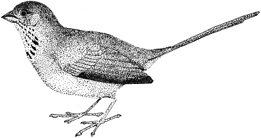
Brownish overall and resident in chaparral, the California Towhee forages mostly on the ground, sometimes scratching among the leaf litter.
Based on our interpretation of the behaviors observed, the birds seen along the Creek Trail are in two different families. Start by flipping through the field guide and looking not necessarily for the specific bird but for a family of birds that resembles what you saw. Read the family descriptions as you do this. Once you find the probable family, search for a bird that matches not just the appearance but also the range and habitat of what you saw. Look at the graphics and read the text. Flycatcher bills might look right, but the description will tell you that flycatchers generally hunt insects in the air from an exposed perch, which is clearly not what you saw.
The bill picker likely has a longish bill that is straight or down-curved, the typical pattern for ground-feeding, insect-eating birds. As you go through your guide, thinking about tails and bills, a number of possibilities will catch your eye, but most will not stand up to scrutiny. A liberal list for the bill picker might be Mourning Dove, Hermit Thrush, California Thrasher, and maybe even Wrentit.
The Mourning Dove is long and low with a long tail. Mourning Doves feed on the ground and have longish bills. The Hermit Thrush is a ground feeder that can be found in the area, but it has a stubby tail, and the illustrated posture is very upright. The Wrentit has the right body shape and dimensions, and it is a chaparral bird. It’s rather small, though, unless we overestimated the size of the bird sighted. Finally, the thrasher looks right in body structure and dimension and has the ideal bill for the foraging behavior we observed.
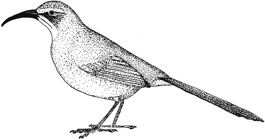
Hermit Thrush (a), Mourning Dove (b), Wrentit (c), and California Thrasher (d).
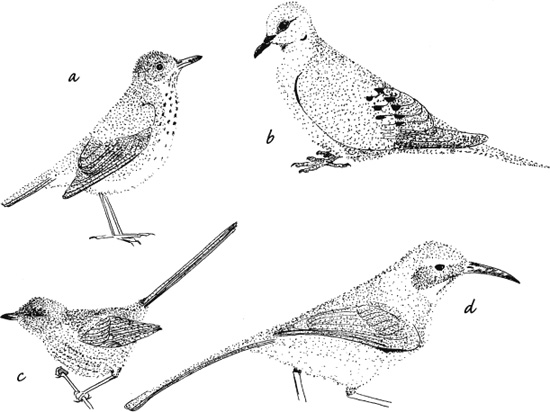
Some Southern California members of the family Emberizidae—the sparrows and allies. Junco (a), Rufous-capped Sparrow (b), California Towhee (c), Spotted Towhee (d).
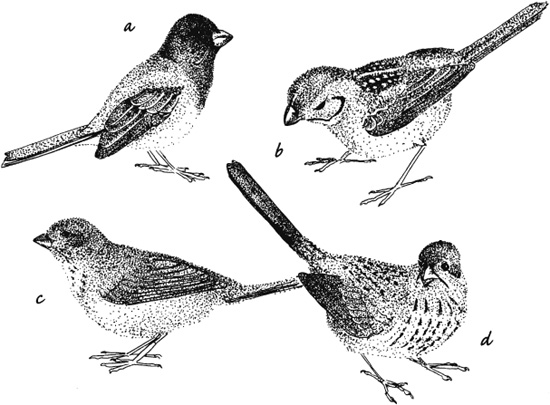
Drab-colored and common in chaparral-covered foothills, the California Thrasher uses its large, curved bill to flip leaf litter aside as it forages on the ground.
A simple reference that provides a little more natural history than the typical field guide would likely clarify the picture. Of all the birds listed, only the California Thrasher is uniformly dark brown, has a long tail, picks through leaf litter with its bill (“thrashing”), and is common in chaparral. This is exactly why a good natural history reference is an important tool for building your skills in the field. It’s also helpful to look at the photos or paintings of birds in several guides, seeing them in different poses.
The first thrasher I ever identified was a California Thrasher in just this situation. What clinched it for me was knowing that thrashers “thrash” and having an impression of their long shapes from time spent poring over a field guide. After the bird flew off, I followed it over the hill, found it again (I heard it in the leaves), and snuck up for a closer view. I just needed a good look at that bill to positively identify the bird in the guide. Only much later was I able to watch a few of them closely enough to pick up all their other field marks.
Working on identifying the scratcher, only the emberizid, cardinal, and finch families exhibit the ideal “conical” seed-cracking beak we presume that it has. However, most of the species in these families are small, colorful, or found outside of this location. The most likely matches are among the emberizids—the sparrows and allies. These birds are a little more similar than the short list for the thrasher. Identifying this bird will ultimately depend on plumage color and pattern, because all these birds fit the structural, range, and habitat criteria. If we can be sure that it was a medium-sized bird that lacked streaking and patterning, that leaves only the California Towhee with the necessary traits. In order to settle on a single bird, you need to have a sense of why it couldn’t have been something else.
Note that if you had seen a smaller, streaky bird in that same scenario, your job would have been much harder. Species identification often rests on the details, and in those cases, you may not walk away from a sighting with a positive identification. You would, however, be much better prepared to get it right the next time.
Now you know the names of the birds you saw, but that’s just the beginning. When you visit that spot again and see a bird in the shadows, you might think, “That bird sure isn’t acting like a California Towhee.” Even better, now you can read up on these birds in your field guide and other resources. If you do, you’ll learn—like I did, after my first sighting—that the California Towhee commonly gives a metallic chink! as a call note. The next time I was out for a walk, my mind suddenly registered that I had been hearing these notes almost constantly without even realizing it. Suddenly I was identifying California Towhees everywhere simply by this sound and a quick rustle in the brush.
Birdsong and other vocalizations are valuable tools for birders. In addition to songs, many birds make distinctive calls throughout the year that are fantastic aids for identification. Using vocalizations is easiest when you prepare ahead of time. Choose a few common species on which to concentrate, and review and learn their songs and calls before going into the field. When you’re adept at recognizing those first few, tackle a few more.
There are some good resources for songs and calls, but the best way to learn birdsong is to use those resources to make your own recordings. For example, if you want to learn the robin, record its vocalizations from a commercial tape or CD several times over. Then do another repetitive recording for, say, the mockingbird. When you listen to the recording, you’ll hear the robin song five or six times in a row, followed by similar repetitions of the mockingbird. You can do four or five species this way. This will familiarize you with their songs much faster than if you simply listened to an entire CD of all the birds in the east or west over and over.
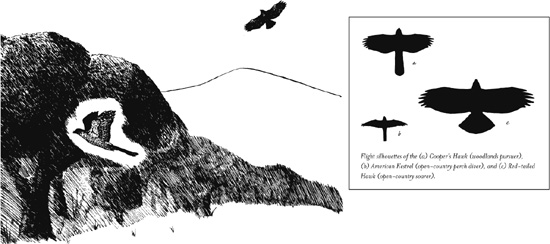
A Cooper’s Hawk flaps to a new perch while a Red-tailed Hawk soars overhead.
A friend of mine spent one summer surveying breeding birds in his hometown as part of a statewide research project. He admitted that he had to relearn all the songs each year because, for some reason, they never stuck with him. In addition to doing some good focused preparation of the sort mentioned above, he shared a new technique that I hadn’t thought of. He carries an iPod into the field so that he can play through the candidate songs on site and compare them to the actual songster. The key to this handy trick is that he has a base of knowledge about the songs of certain families or groups of species, making his in-the-field recording search narrow and efficient.
Approaching your field observations from an ecological perspective prepares you to see patterns that were previously invisible. Your field guide can tell you how things look. I want you to think beyond mere appearances—in terms of the underlying patterns of ecological life. Form, function, and environment are interacting parts of a whole organism. As you apply this perspective, you will learn to recognize a bird’s family or even subfamily at the first sighting. As you saw, simply noticing where the bird is in the habitat can imply family through traits such as feeding behavior or beak shape.
I once asked myself why so many chaparral birds have long tails. There seemed to be a pattern in the wings of many species, too. Scrub Jays, for example, have long tails and broad, stubby wings that make a fluttery sound when they fly. Why this shape? This is the question I began carrying in my head as I walked and watched. It was a simple question, but it deepened the impact of my daily observations.
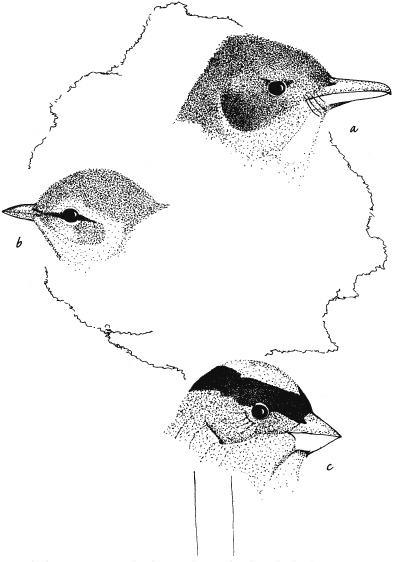
Microhabitat can provide clues to how a bird might look or act. Here, a Western Wood Peewee (a), an Orange-crowned Warbler (b), and a Golden-crowned Sparrow (c) are shown at the relative heights where they are seen in oak woodlands or chaparral.
One day I followed the Creek Trail into the high meadow. I was sitting in the stubble of the recently mowed field watching nothing in particular when I saw a Red-tailed Hawk soaring above me. As I watched, another bird came up over the lip of the hill beside me. This second hawk shot right over my head about 20 feet off the ground. I had a great view of it as it sailed away and disappeared deep into the opposite wood line. I knew what kinds of hawks might be in the area, and I had seen enough to be sure that it was a Cooper’s Hawk that shot over my head. Seeing that Cooper’s Hawk answered my question about why I was seeing so many birds with long tails.
A Red-tailed Hawk hunts by soaring high above the ground and looking down for prey. It spends many hours each day circling and drifting without flapping its wings. When a redtail soars, it spreads its long, broad wings and flares its tail into a short wedge. It makes its body into a wide paraglider, allowing it to catch rising currents of warm air and ride them all day long. If you watch a redtail soar in unstable air, its tail is constantly angling this way and that, balancing the airflow over its body. The tail is the steering mechanism, and the wings provide the lift. The spread of the primary feathers on the ends of the wings decreases drag and lets the hawk soar at very slow speeds without stalling and falling from the sky. Redtails are often seen hunting from perches along highways. Whether hunting or roosting, they often perch in the uppermost part of a tree for better access to their primary element, the open sky. Redtails rise from their roosts slowly, with heavy wing beats. Those long, broad wings that are so excellent for soaring are tiresome to flap—a trade-off in efficiency between soaring and active flying.
In contrast, a Cooper’s Hawk has short wings. It spends less time soaring, preferring to hunt from a roost within the woods. The Cooper’s Hawk perches under the upper canopy and watches for prey, usually small birds, which are pursued and captured in the air. Its short, broad wings are more efficient for flapping than a redtail’s are. They catch a lot of air, allowing the Cooper’s to fly quickly and with great agility. The long tail gives it even more power in its maneuvering, a critical capability for aerial pursuit in canopied woodlands.
All hawks and their close relatives have the same basic features—grasping talons, tearing beaks, flying wings, and steering tails—but in each species, those features are molded to suit a particular prey and habitat. The Cooper’s Hawk is a hawk built in the bird-chasing woodland mold. The Red-tailed Hawk soars high over open country as it hunts for small rodents and rabbits. The American Kestrel, a small falcon, hunts from an exposed perch in open territory. It doesn’t need broad wings or a long tail for bursts of speed and maneuverability, but it must be able to drop quickly from a perch when it spots a grasshopper. Accordingly, kestrels have narrow, pointed wings.
Members of the flycatcher family are calm, stately birds. They usually sit on mid- to high-elevation perches from which they fly out and catch insects on the wing. Their bills are broad at the base, open wide, and have “whiskers” and a hooked tip to help catch and hold prey. Warblers are small, often brightly colored, “nervous” birds that pick soft insects off the foliage of trees and bushes with their small pointed beaks. Sparrows generally have stout bills, thick from top to bottom, for leverage in cracking seeds. They are found mostly on the ground and often in flocks.
These aren’t hard-and-fast rules, but they are valuable. Even if you can say that a bird is warblerlike, you are well on your way to identifying its family and maybe even the bird itself—and you are learning a deeper story about the living landscape. Ecological and family traits give you a place to start. Then you can search for the details that distinguish one species or another within that group. Those field marks illustrated in your field guide that used to seem like an endless parade of obscure details will now fit easily into a rich and expanding picture of birds and bird life.
—From A Naturalist’s Guide to Observing Nature
Elizabeth P. Lawlor
Illustrations by Pat Archer
There are many excellent guides to bird identification from which to choose, and they are available in most bookstores. You will find some of the most widely used field guides listed in the Bibliography. If you are a beginner at bird identification, you might prefer to use a guide that covers only your region rather than a more inclusive guide that describes the birds that live in all of North America. Expert birders and teachers at nature centers can be extremely helpful to you as you sort through the large selection of available bird guides. As you become more proficient in bird identification, you may find that your first guide does not provide all of the information you would like to have at your fingertips. Seasoned birders own several field guides and use them regularly.
Once you have selected your field guide, read the introduction and skim through the rest of it. You will notice that the birds are grouped according to families. What kinds of information are given about the bird families? If the guide has range maps, what do the maps tell you? Why are the loons at the beginning of the guide and the passerine or perching birds at the back of the book? Get to know your guide; read through it whenever you have some extra time. The more you use your guide, the easier it will be for you to identify that mysterious bird that visits your feeder.
A good way to learn to identify birds is to go on bird walks. Look in your local newspaper for bird walks sponsored by a local bird club or a local chapter of the National Audubon Society. Nature centers and museums also sponsor walks.
The early stages of bird identification can be the most confusing and discouraging. This diagram of a bird will help you focus on the features that are commonly used to distinguish one kind of bird from another. Birders refer to these features as field marks.
Your first task when you see an unfamiliar bird at your feeder is to pay attention to the most general features of the bird—its size, shape, and color or color pattern. Next, observe specific details, such as the bird’s bill, tail, head, wings, and feet. The bird’s flight pattern can be another clue to its identity.
SONGBIRD ANATOMY
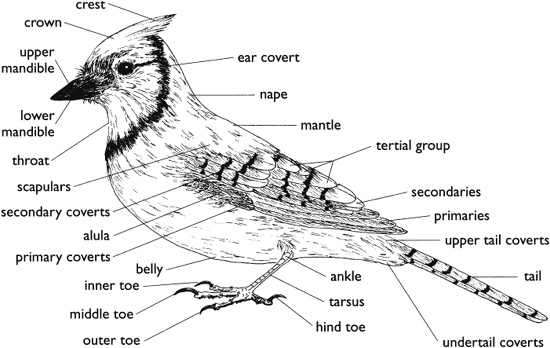
FAMILIAR BIRD SILHOUETTES
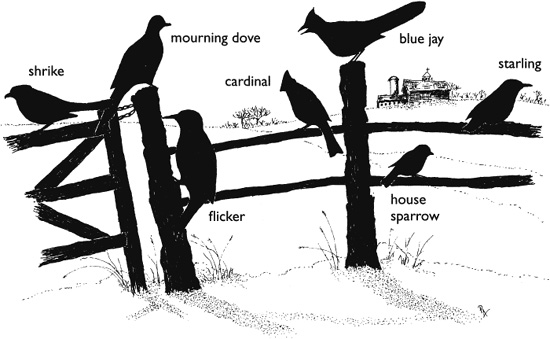
Size. Nearly everyone is familiar with the crow (seventeen to twenty-one inches), a robin (nine to eleven inches), and the sparrow (five to seven inches). These birds can be used as a mental measuring tape for determining the approximate size of your “mystery” bird. Is it smaller than a crow but bigger than a robin? Larger than a sparrow but smaller than a robin?
Shape. Birds can be plump or slender, chunky or sleek. What is the bird’s general shape? Is it sleek like a crow? Chunky like a grosbeak? Stout like a nuthatch? Learning to recognize bird silhouettes against the gray of a winter sky or other drab background can be very helpful. Starlings, for example, differ from other birds of their size in that they have very short tails.
Color (Pattern). What color is the bird? Is there more than one color? Where are the colors? On the bird’s back, breast, belly, rump, wings, or tail? Does it have wing bars? Does the color appear carelessly splashed on the bird, like the speckles on a starling? Or is it clearly defined, like the dignified black and white pattern of a hairy of downy woodpecker? A bird’s name is often a reflection of its color. Blue jay, American goldfinch, purple finch, and redpoll are a few of the birds that sport their colors in their names.
Bill. Generally, the shape of the bird’s bill identifies the bird’s family. Is the bill long or short, thick or slender, curved or straight? Is there anything unique about it? The crossbill’s beak is twisted, making it effective is prying the seed from pine cones. You probably will not see these birds at your feeder, since they prefer to remain in the coniferous woods. Warblers have short, slender bills, but sparrows have short, thick bills. Warblers are primarily insect eaters, but the sparrows’ thicker bills are good for cracking the hard coats of seeds. The curved bills of brown creepers are effective probing tools for picking out grubs from between the cracks in tree bark.
Tail. What is the shape? Color and pattern? Is it long like the tail of a mockingbird or short like the tail of a sparrow? Is it forked, notched, rounded, or squared off? How does the bird hold its tail (see silhouette for shape)? Does the tail droop or is it held upright like a wren’s? (The “tail up” image comes from the standard guidebook picture of a wren, but they often sing, a spring behavior, with tail pointed straight down.)
Head. What is the color? Is it a solid color or patterned? Are there eye stripes, as in a Carolina wren? Eye rings, as in a tufted titmouse or ruby-crowned kinglet? Does the bird have a crest like a cardinal? A hood or a cap like a chickadee?
Wings. Look for wing bars (thin lines) or wing patches of a lighter color than the wing. The wing bars or patches may have a dark margin that sets them off. The red-winged blackbird shows red wing patches with a yellowish margin when it flies.
Feet. The birds that visit backyard feeders are the perching birds and woodpeckers. The illustration show the difference in the feet of these two types of birds. How does the design of the feet help the birds when they eat? Compare the feet of the perching birds that come to the feeder with those of the woodpeckers that eat from the suet cakes affixed to the tree trunk.
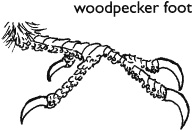
The feet of most woodpeckers have two toes pointing forward and two pointing backward, which helps anchor them as they chisel wood.
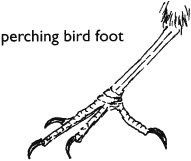
Passerine birds have a single hind toe, which helps them grip a branch when perching.
Frequently birds will fly away from the feeder before you have an opportunity to get a good look at them, but you can get some information about the bird before it disappears. How does it fly? Does its flight pattern resemble a roller coaster, such as woodpeckers and finches? Does it flap, flap, glide? Does the bird fly in a straight line? It might be a mourning dove. Are the wingbeats slower than those of other birds? Perhaps your bird is the slow-flapping mockingbird. You might hear a whistle as the bird files away. This tells you the bird is probably a mourning dove. Woodcocks also whistle as they take off, but you won’t find these birds of moist woodlands and marshes at your feeder.
Certain birds will display additional colors and color patterns only when they are in flight. The slate-colored junco reveals white feathers on the outer margins of its tail when in flight. The towhee will show patches of white on the corners of its tail, and yellow-shafted flickers flash a white rump when in flight.
There are birds that are familiar to most people. When one of these familiar birds visits your feeder, observe it carefully. Make a list of the characteristics that helped you determine what it was. In doing this exercise, you will be applying the criteria needed to identify other birds. Try it. Learning to distinguish one bird from another takes patience, time, and more patience.

The shape of the tail is determined by the relative length of the tail feathers and is useful in field identification.
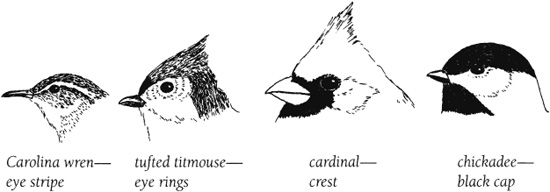
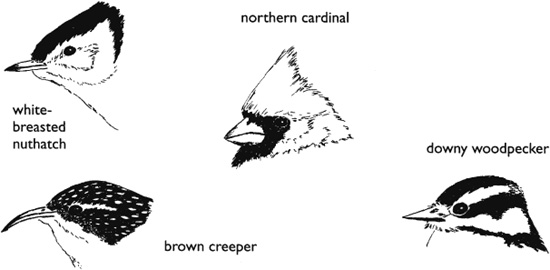
In general, the shape of the bill identifies the bird’s family.

Most songbirds use bursts of flapping to gain altitude, followed by shallow dives with their wings closed.
—From Discover Nature in Winter
Elizabeth P. Lawlor
Illustrations by Pat Archer
You can expect to find abandoned bird nests in the winter, since they are no longer hidden by a thick curtain of leaves. Winter nests are usually vacant, but if you find one covered with leaves, it might be a temporary shelter for a mouse or some other weary traveler; do not disturb it.
Warning: It is against the law to take nests apart or to remove them from trees, shrubs, or any other place you may find them. You may, however, take photographs or make sketches of the nests in your field journal. Also write your observations in your journal. Include any questions you may have so that you can research them later.
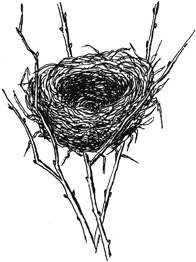
Sparrow nests are neatly cupped grass nests in low shrubs or on the ground.
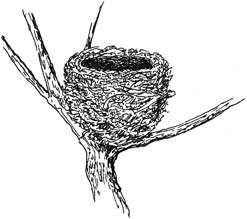
Goldfinch nests are formed of downy materials that show as gray or white in the nest foundation.
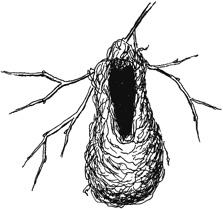
Baltimore oriole nests, woven of yarn, plant fibers, and hair, are found hanging from drooping branches of elms, maples, willows, or apples.
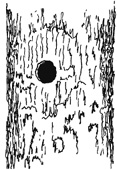
Chickadees, woodpeckers, titmice, nuthatches, and brown creepers nest in excavated cavities in dead trees.
Birds do not use their nests in the same way that we use our homes. For the birds, a nest is a place to lay their eggs, incubate them, feed the hatchlings, and serve as a jumping-off point when the young begin their flight lessons. After the young have learned to fly, the family breaks up, and for most bird species, the nest is no longer used. Some birds raise more than one brood in a season. These birds will build a new nest for each brood.
To find nests, search the trees and shrubs around your home and in your neighborhood. Walk along the edges of fields, look in thickets, on the ground, and in clearings. Look for dark clumps at various levels in the trees. Do not mistake the large, leafy summer nests (dreys) of squirrels for bird nests. When you spot a nest, record its location in your notebook. If the nest is in a tree, how high is it? Is it in the crotch of a limb, near the end of a branch, or close to the trunk? How many nests are there in the same tree? Include in your description the type of tree or shrub where the nest was found so that you can find it again.
Make a chart that shows the distribution of nests in your neighborhood. Have a friend make similar observations in his or her neighborhood and compare your charts.
About 77 percent of the birds in North America build open nests, and they come in a variety of sizes and shapes. The remaining birds raise their young in holes or in structures with rooflike tops. Blue jays prefer to build their bulky but well-hidden nests in conifers, generally ten to twenty-five feet off the ground. The nests are made of thorny twigs, bark, moss, string, and leaves. Robins build nests with weed stalks, strips of cloth, string, and grasses woven into soft mud. Robins and blue jays will build nests close to human habitation, so look for them in trees in neighborhood yards and along the roadside. Baltimore orioles build their pouchlike nests of plant fibers, hair, and yarn high in the trees, generally twenty-five to thirty feet above the ground. The rose-breasted grosbeak prefers to nest in moist, deciduous thickets and suburban trees and shrubs. It builds its flimsy nest of twigs six to twenty-five feet above the ground. The redeye vireo’s delicate nest of bark, grasses, vine tendrils, and paper is decorated on the outside with lichens. You can find these nests five to ten feet above the ground, suspended in the forked branches of saplings. Wood thrushes build compact nests of grasses, bark, moss, and paper, held together with mud. Their preferred sites are in deciduous trees, usually ten feet above the ground in parks or gardens. Wood thrushes appear to be growing more tolerant of human presence.
Because of the regulations against taking nests from the places where the birds built them, you may not have the opportunity to see many nests up close. Museums, nature centers, and other educational facilities may have collections of bird nests for you to examine. Compare those nests with the nests you found. What are the similarities and differences?
Take photographs wherever possible. You can add the photos to your filed notebook or build a special notebook just for birds.
—From Discover Nature in Winter
Elizabeth P. Lawlor
Illustrations by Pat Archer
During the millions of years that birds have been on earth, they have developed several strategies that help them survive the rigors of winter. One of these strategies is to migrate south from their northern breeding grounds to more hospitable lands. By late summer, birds that thrive on flying insects, such as orioles, flycatchers, thrushes, and warblers, are on their way south. Although their favored food is more readily available there, life in the land of sunshine has its own problems. The new arrivals must compete with native birds not only for a share of the bounty but also for territorial space in the rapidly diminishing woodlands and rain forests.
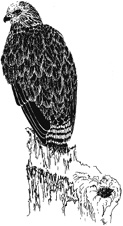
Rough-legged hawk.
Birds that can find sufficient quantities of their preferred food remain in their northern breeding grounds throughout the cold months. Others that winter in the North simply change their diet. Instead of foraging for active insects, these birds find high-energy substitutes in such fare as dormant insects and seeds.
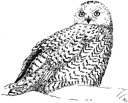
Snowy owl.
Sometimes there is not enough food in a region to support the huge numbers of birds that survive a very successful breeding season. Such a sudden population increase is known as an irruption. In response to this crisis, generally in late autumn, massive numbers of birds begin to flock into our northern states from Canada, where they have bred and where they usually spend the winter. It is not unusual for such birds to travel thousands of miles in search of scarce food.
Such movements by raptors like rough-legged hawks and snowy owls can be predicted because they are directly related to food supply, such as the number of lemmings available in the far north. At such times, snowy owls have been reported foraging on the beaches of Cape Cod and Long Island. Similar movements of northern shrikes depend on the abundance of mice in the birds’ northern breeding grounds. Every three to five years the prey populations decline, and by November bird-watchers who live in the northern states such as Maine, Vermont, New Hampshire, New York, and Michigan report an increase in predaceous shrikes.
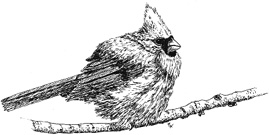
Northern cardinal fluffing its feathers on a cool winter day.
The mass movements of seed-eating birds are less predictable. They usually remain in their northern breeding grounds over the winter. Seeds from deciduous trees such as birch and aspen and the seed-laden cones of conifers normally sustain them throughout the winter. Movements of these birds into more southerly areas are difficult to predict because seed production depends on the vagaries of the weather—a warm spring and a warm autumn are necessary for a large crop of seeds. A bumper crop in one year does not mean a similar harvest the following year. In years of poor seed production, birds from the boreal forests descend across the Canadian border. At such times, residents of the northern states may see unusual winter visitors, such as redpolls, evening grosbeaks, pine grosbeaks, pine siskins, and red-breasted nuthatches, foraging with familiar winter birds such as cardinals, tufted titmice, and blue jays.
Migration and movements due to population surges are strategies for winter survival that are related to food supply. Except for those that migrate to tropical or semitropical climates, most birds must still cope with the frigid days and nights of winter.
Birds have evolved several strategies for surviving in cold weather. Some strategies cost very little in terms of energy use; others are extremely expensive. One of the least expensive survival techniques involves the birds’ feathers. As the temperature goes down, birds fluff up their feathers through the workings of tiny muscles located in their skin. The fluffing action traps and holds the air surrounding the skin, which has been warmed by the birds’ internal temperature (102 to 107 degrees F.).
Another, more expensive, strategy is to grow a more dense cover of feathers. Birds that winter in the cold climates have relatively more feathers than migrating birds. Tiny birds such as chickadees, kinglets, and creepers have more feathers relative to their size than the larger birds.
Most warm-blooded animals have devised a natural defense against life-threatening cold: They huddle. The smaller the animal, the more beneficial this strategy can be. Many birds use this strategy to keep warm, huddling together in trees, nest boxes, or any place where there is protection from ice storms or chilling winds. This roosting behavior helps minimize the difference between the body temperature of each bird and that of the surrounding air. When groups of birds huddle together, the heat lost from the group as a whole is similar to that lost from one large animal. Large animals have a smaller surface area relative to their size than smaller animals, thus they lose relatively less heat than smaller animals. The huddled “big bird” in the roost stays warmer than each of the little birds could if left alone in the cold. Scientists have learned that a cluster of house sparrows huddling in a nest box can save about 13 percent of the energy required to keep warm at night. Some birds, such as ruffed grouse and common redpolls, use the insulative properties of snow to protect them from the bone-chilling night air.

Counter-current heat exchange in the legs and feet of a mallard.
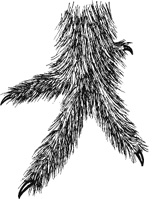
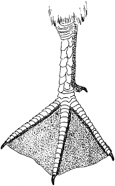
In winter, ptarmigans grow stiff mats of feathers on their toes and thick feathered leggings.
Shivering is another strategy birds use to keep warm. Because this method of getting warm has a high energy price tag, birds must eat large quantities of high-energy (high-fat-content) food to pay the debt. American goldfinches, for example, increase their body weight by 15 percent after a day of foraging. The payoff for the birds is that they can convert food into heat energy four to five times faster when shivering. They could not maintain the shivering if they had not eaten so vigorously. With their engines running at top speed, these birds can endure temperatures as low as minus 40 degrees F. The ability to increase their metabolic rate is believed to be triggered by the diminished light of winter. In the summer, when the days are longer, the birds can metabolize at such a high rate for only an hour. During the short days of winter, they may need to metabolize rapidly for many hours at a time.
Some birds use an opposite strategy, reducing their body temperature during periods of inactivity. When resting, chickadees can reduce their body temperature by about 50 degrees F., which slows their metabolism by 23 percent. This conservation strategy safely carries them through the night with sufficient reserve to fuel early-morning foraging activities. Hibernating animals usually have very low metabolic rates for long periods of time. Although we do not ordinarily associate hibernation with birds, poor-wills and possibly swifts are known hibernators in the bird world.
Most birds’ legs are covered with scales, which do not protect from the cold. Those staying the winter in cold climates have shorter legs than their relatives living in warmer regions. This is a structural strategy that helps them conserve heat. Some birds have developed a protective behavior, frequently tucking one leg under the breast feathers to reduce heat loss. Look for these one-legged balls of feathers in trees and shrubs during the next cold spell.
Something called counter-current heat exchange also helps birds reduce heat loss through their legs and feet. It works in an interesting way. As in other animals, blood flows through arteries from a bird’s heart to its extremities, while blood returning to the heart flows through veins. In birds’ legs, arteries and veins are close to each other so that warm arterial blood passes some of its heat to the cooler blood in the veins. When the cooled arterial blood reaches the feet, considerably less heat is lost to the environment. In addition, this system decreases the potential shock to the birds’ bodies from cold blood returning from the extremities.
A few winter-adapted birds have feathers that protect their legs from the cold. Ptarmigans wear feathered leggings and dense mats of stiff feathers on their feet. The legs of snowy owls are also sheathed in feathers.
Even with these adaptations for cold weather, mortality is high among birds that winter in cold climates. As many as 50 percent of chickadees wintering in the North do not live to sing the next spring. Scientists believe that many of these deaths are among the first-year birds, which may not have had access to good roosting sites or feeding grounds. Fierce winters are not as damaging to bird populations as are early freezes and unseasonable bad weather. Many strategies birds use to carry them through the winter are controlled by shorter days, so an early autumn can do as much damage as a severe winter.
If you live in Vermont, you may find that only about twenty species of birds spend the winter in your neighborhood, but if you live in Maryland, there may be over a hundred species. It is truly amazing that any of these tiny creatures can survive the low temperatures, snow, ice, and killing winds. Winter is certainly a challenge for birds.
—From Discover Nature in Winter
Richard P. Smith
Illustrations by DeCourcy L. Taylor, Jr.
Unlike mammals, birds only walk on two feet and they normally have four toes on each foot, three facing forward and one back, although the fourth toe does not always show in tracks. The rear toe is usually the shortest of the four.
There are exceptions to this pattern, though. The long-tailed, brown, crest-headed roadrunner of the arid southwest is a perfect example. This relatively large predatory bird of cartoon fame that feeds on snakes and lizards, among other things, has two toes forward and two backward. The tracks from one of these birds measured as much as 3 inches in length.
The flicker is another bird with toes that do not fit the normal pattern. There are two toes forward and two backward like the rest of the woodpecker family that flickers belong to. One toe facing each direction is smaller than its mate. Unlike other woodpeckers, I have seen flickers feeding on the ground on a regular basis, so there is a possibility of seeing their tracks. The length of one flicker track along the longest toes was 1 ¾ inches.
Flickers have prominent red patches on the backs of their heads and are brown on their backs with black-spotted white breasts. A black, biblike marking is on the chest forming the upper margin of the spotting.
Getting back to bird tracks in general, there are two basic types of track patternsæhopping and walking. Birds that hop will make tracks with both feet side by side. A series of single tracks, one ahead of the other, are made by walking birds. Birds that spend most of their time perched in trees such as songbirds have a tendency to hop, while birds that spend a lot of time on the ground like quail, grouse, and pheasant walk or run.
For the most part, songbirds leave slim-toed tracks showing four toes, with the rear toe at least as long as the other three. Their tracks measure between 1 and 2 inches in overall length. Quail tracks like the bobwhite and California variety leave prints about 2 inches long, with much thicker toes than songbirds. If the rear toe is visible, it is short and angled off to one side, rather than facing straight back like the footprints of songbirds.
I remember flushing large coveys of California quail with my father and brother in Southern California as a boy. Some coveys contained upwards of fifty birds or more. They occupied brushy valleys and foothills. The males are a blue-gray in color, with large dark patches outlined in white starting under the eyes and covering the throat. Patches of rust coloration are on the lower breast. Males and females have fingerlike top-knots curved forward on their heads. Females are brown in color. Gambel and mountain quail are similar to the California variety. Scaled quail are brown to gray in color with a band of what looks like fish scales on the breast and back of the neck. They also have crests on top of their heads.
The California quail’s original range included the southernmost portion of Oregon, most of California and Mexico. They have since been introduced into much of Oregon and parts of Washington, Idaho, Nevada, and Utah. The gambel quail’s stronghold is Arizona and adjacent portions of Utah, Nevada, California, New Mexico, and Colorado in arid regions. Mountain quail, as the name implies, are typically found at higher elevations than the other quail in California, Oregon, Washington, and Idaho. Scaled quail inhabit western Texas, most of New Mexico, and nearby portions of Oklahoma, Kansas, Colorado, and Nevada.
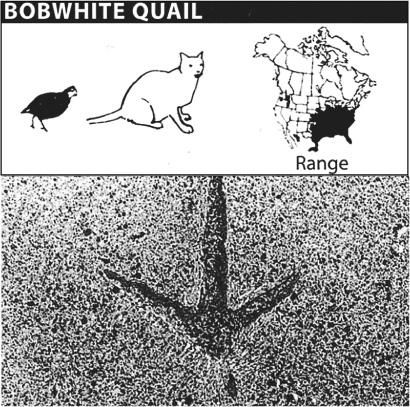
Grouse tracks are similar to those of quail, but toes are noticeably thicker and longer.* Tracks are between 2 and 3 inches in length. Some of the birds that fall in this group are ruffed, sharptail, spruce, blue, and ptarmigan. Pheasant tracks are very similar.
The habitat and part of the country where these types of tracks are found are indicative of what species made them, although there is some overlap in the ranges of these birds. Ruffed grouse are birds of woodlands and are common in the Great Lakes Region, the eastern United States, and parts of the south, plus states in the northwest. They are also distributed throughout most of Canada and into central Alaska.
As an adaptation for walking in snow, ruffed grouse grow scales along each toe in the fall and shed them in the spring. Tracks of a number of birds can be seen together at times. Ruffed grouse are brown and gray in color with light breasts that have dark bars across them. They got their name from a collar of black feathers usually extended by males when displaying for a female. The rear margin of tail feathers have bands across them producing a continuous band across the tail when it is fanned.
Spruce grouse are found primarily in spruce and jackpine forests. Females are sometimes mistaken for ruffed grouse, being a mottled brown. Males are black. Spruce grouse are also known as “fools hens” due to their habit of letting people approach close enough to kill them with rocks or sticks in some cases. On one occasion I watched Dr. William Robinson, who has studied the birds for years and wrote a book on them aptly titled Fool Hen, catch one of these birds by hand, and it was not the first time he had done it.
The distribution of spruce grouse is similar to that of ruffed grouse, except they have a more limited range in the United States (restricted to northernmost states) and is established across a wider area in Canada and Alaska.
Sharptail grouse prefer open country with few trees, although they do spend some time in groves of trees near openings. Flocks of sharp-tails are common. These birds are tan in color with white breast feathers and short, pointed tails. Both sexes look alike. Their range includes most of the Dakotas, northwest Nebraska, eastern Colorado, eastern Montana, the upper Great Lakes Region, plus much of central Canada and Alaska.
Blue grouse inhabit mountainous regions and the coniferous forests associated with them. The birds are blue-gray in color. They are found primarily in the northwestern United States and Canada, with largest populations in Colorado, Utah, Wyoming, Idaho, Montana, California, Oregon, and Washington. Blue grouse are distributed throughout British Columbia and into the Yukon, plus southwestern Saskatchewan.
Ptarmigan are also mountain grouse, usually living in treeless habitat above timberline or on the tundra, and occur in small flocks. They grow feathers on their feet for the winter. These birds are generally gray to brown in color in the summer and turn white for the winter. Either one of the three species of ptarmigan (rock, willow, and white-tailed) range throughout western and northern Canada and Alaska, and southward in some western states including Washington, Montana, Idaho, Wyoming, Colorado, and New Mexico.
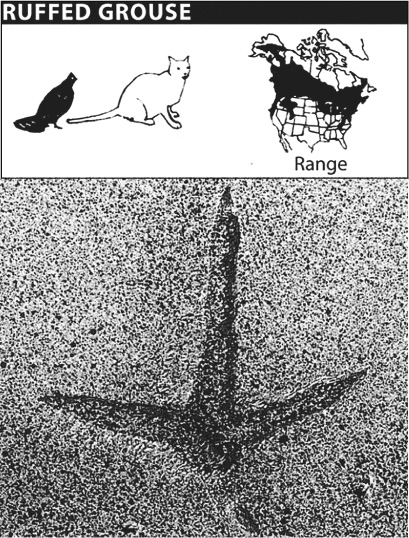
Pheasants are often associated with agricultural areas, with groups of birds present in some fields. Males are colorful, having coppercolored bodies, iridescent blue-green heads, red around each eye, and white rings around their necks. Females are a mottled brown. Both sexes have exceptionally long, pointed tail feathers. Though these birds are now found in a band of states from the northeast to Montana, and in the southern portions of several Canadian provinces (Alberta, Saskatchewan, and British Columbia), they are not native to North America.
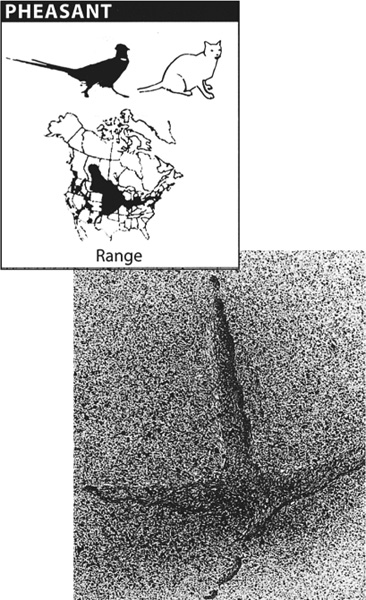
Pheasants were introduced here from China many years ago. The band of states the pheasant’s range includes in the United States is narrowest in the northeast and is widest at mid-continent, going as far south as the northernmost tip of Texas at that point. Some birds are also distributed in parts of every western state.
Turkey tracks will measure 4 or more inches in overall length in correspondence with their size. Males reach weights of 20 pounds or better while females weigh in the neighborhood of 10 to 15 pounds. To tell the difference between hen and gobbler tracks measure only the length of the middle toe. Those toes are more than 2½ inches on adult toms and less than that for hens. A distance of at least 8 inches separates tracks made by gobblers and the stride of hens is just over 7 inches.
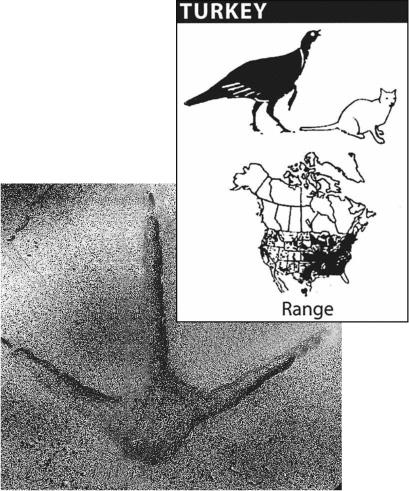
Male turkeys possess beards that grow out of the chest. Wattles, which are normally red, are on the head. The head itself may be red or blue when aroused. Gobblers appear black in color while hens look brown and have naked, dull-colored heads. Hens occasionally grow beards.
Wild turkeys are distributed all across the southern half of the United States from Texas and Oklahoma eastward, with populations established further north in New York, Pennsylvania, Michigan, along the borders of Wisconsin, Minnesota, and Iowa, and in the Dakotas. West of Texas, turkeys are established in parts of Nevada, New Mexico, Arizona, Colorado, Wyoming, Montana, Idaho, Oregon, Washington, and California.
Tracks of the sandhill crane can be confused with those of turkeys. However, the toes of sandhills are slimmer, have relatively straight edges and are smoother on the underside than turkey toes. Jointed, callous-type pads are on the bottom of turkey feet, and this characteristic sometimes shows in clear prints. Sandhill tracks resemble turkey prints in size, measuring 4 inches or less.
There are two major subspecies of sandhills—greater and lesser. Greater sandhills are much larger than their relatives. The birds have long legs and are gray to brown in color with the tops of their heads being red. Both males and females look the same. Interestingly, the birds are named after horses, with females referred to as mares, males as roans. And, of course, their young are called colts.
Sandhills nest in the upper Great Lakes Region, plus a group of states in the northwest, and most of Canada and Alaska. Since the birds are migratory and winter in the south, they can be seen virtually anywhere. They nest in bogs, but feed in fields, both noncultivated and agricultural.
Great blue herons leave longer tracks than turkeys and sandhills because their fourth toe shows in prints. One track measured between 6 and 7 inches in length. Even without the rear toe, blue heron tracks are distinctive. Two toes on the inside of each foot are close together with a noticeable gap between them and the toes on the outside.
These migratory birds are blue-gray in color with light-colored breast and head. Long feathers on the chest hang down away from the body and there is a crest or top-knot on the head. Herons are long-legged like cranes. They build colonies of large nests called rookeries in trees over or near water. Blue herons are always associated with water where they feed on fish, frogs, and other items.
Shore birds such as sandpipers, yellowlegs, and snipe make narrow-toed tracks. Short rear toes may or may not be visible in prints. Small shore-bird tracks are less than an inch long, with those of larger varieties approaching 2 inches. The middle toe is noticeably longer than those on the sides in the tracks of larger shore birds. Their tracks are sometimes abundant in the mud or sand along oceans, lakes, ponds, or rivers. Small round holes left by long, pointed beaks may also be visible where the birds were probing the mud for insects or worms.
Woodcock, a bird of the uplands resembling snipe, make similar tracks, only their prints will be visible in the mud of woods roads most often, although they do feed along the shores of rivers and ponds, too. Incidentally, I have seen some snipe in upland habitat with woodcock, so snipe are not “shore-birds” exclusively. Woodcock tracks are about 1¾ inches in length on the average and probing holes may be visible nearby. Snipe tracks may be smaller, measuring about 1½ inches.
Snipe are white and black in color. Woodcock are brown and black, with bulging eyes that are larger than those of snipe well suited for seeing at night. The winter and summer ranges of woodcock encompass the eastern half of the United States and southern Canada. Snipe are distributed throughout North America.
Web-footed birds include ducks, geese, swans, and gulls. Webbing may not be visible in all tracks though. Only three toes are usually present. Waterfowl tracks usually have marks from toenails visible at the ends of toes. Duck tracks range from less than 2 inches in length for small teal to 3 inches for mallards. The prints of herring gull I measured were 2½ inches long and a glaucous gull left prints measuring a little over 3 inches. One Canada goose track was 3 inches long, but smaller subspecies have duck-size feet. Swan tracks are largest, taping 7 inches or more.
Look for waterfowl tracks in the mud or snow along lakes, ponds, and rivers. However, those are not the only locations where their tracks will appear. Both ducks and geese feed on grain and grass in fields where imprints may be left in mud. I have also seen goose tracks in sand and gravel pits where they have stopped to rest.
Scavengers such as crows, ravens, and magpies make four-toed tracks. The three forward-facing toes of ravens and crows leave impressions closer together than most other bird tracks I have seen. This is because the outside toes face forward more than to the sides like those of other birds. The tracks of magpies are about 2 inches long, with crow prints ranging between 2½ and 3 inches, and raven feet leave prints from 3½ to 4½ inches in length.
Look for their tracks in the sand or snow around the carcasses of dead animals, especially those killed by cars. However, ravens have also clued me in to the locations of both hunter-killed and winter-killed deer. Magpies have long, narrow, black tails with bodies that are black and white. They are seen most often in western North America. Both ravens and crows are totally black, with ravens being the larger of the two. Ravens have slower wingbeats than crows and tails that are more rounded on the corners as opposed to the squared off tails of crows. Ravens are found primarily in the northern United States and into Canada, while crows enjoy a wide distribution in North America.
—From Animal Tracks and Signs of North America
Elizabeth P. Lawlor
Illustrations by Pat Archer
Today, there are 3,800 known species of frogs worldwide, 82 of which live in North America. Frogs are amphibians, which means that in the course of their lifespan they lead a “double life,” first in water and then on land. As eggs and larvae they are bound to a watery existence in freshwater ponds, streams, lakes, or even puddles, but then as adults they adapt to life on land. Scientists place frogs in a special group of amphibians called anurans. The word means “without tail” and distinguishes frogs from salamanders and caecilians. …
Some frogs live for as long as nine years, but most live about four. Therefore, frogs living in cold climates need some strategies for surviving the winter. American and spadefoot toads sleep in burrows beneath the earth; wood frogs and gray tree frogs (Hyla versicolor) prefer to overwinter on the forest floor or in rock crevices covered by leaf litter. Green frogs find shelter on the bottoms of ponds, lakes, or streams, whereas northern leopard frogs snuggle into the soft ooze of streambeds, lakes, and ponds. Scientists know a great deal about the breeding life of many frog species but little about the way they spend the rest of their year. …
Adult frogs must live near water to reproduce, thus water remains essential to the success of the species. During the breeding season they need to mate and deposit their eggs in water because frog eggs are wrapped in a gelatinelike material that easily dries out, rather than a calcium case or leathery shell like bird or turtle eggs.
Although most adult frogs do not drink, all frogs absorb water through their permeable skins, especially the abdominal skin. Some frogs sit for some time during the day in small puddles to replace the water lost through their skin or used in metabolism. Frogs of one species counter water loss by secreting a waxy substance and rubbing it on themselves. Tree frogs have evolved another strategy: they spend the hottest part of the day with their abdomens pressed against the bark of a tree, which minimizes water loss through their permeable abdominal skin. It could be that the problem of water loss is a factor in making frogs creatures of the night, because the night is cooler and more moist. The daytime sun can make it dangerous for frogs to be out.
Herpetologists—those who study the life and times of frogs—are becoming more and more concerned about the amphibians’ future. The reports from 1989 and 1990 conferences held by the World Congress of Herpetology and by the Biology Board of the National Research Council cite an alarming worldwide decline in some frog species. Though scientists agree that frogs have had to cope with predators and variations in rainfall, they point out that because frogs absorb moisture through their skin, they are susceptible to pollutants dissolved in the water such as insecticides and pesticides. These chemicals are leached from the land as rain and melting snow drains into frog breeding ponds. Frogs are also gravely affected by acid rain. Habitat destruction through the draining of wetlands for homes and agriculture by humans is another cause of their decreasing numbers, and frogs are killed by cars, generally on roads that separate breeding pools from winter resting places.
Frog voices calling from bogs and swamps as soft rains fall on the still-cold earth stir a sense of hope and of regeneration every spring, but there may come a time when we won’t hear those magical sounds. Frogs, like the birds, are warning us that there is a problem with the environment; these beautiful creatures are telling us that something is very wrong in the frog pond.
People tend to lump all frogs into a few simple categoriesæpond frogs versus toads, big frogs versus little frogs—but the world of nature is much more complicated than that. Even in the world of the frogs it is beautifully diverse. Scientists have organized frogs into several groups: tailed frogs, narrow-mouthed toads, spadefoot toads, true toads, cricket frogs, chorus frogs, tree frogs, and true frogs. The activities in this chapter focus on a few of the most available frogs in each major group, as follows:
• Spadefoot toads—eastern spadefoot toad (Scaphiopus holbrooki)
• True toads—American toad (Bufo americanus)
• Tree frogs—spring peeper (Pseudacris crucifer), gray tree frog (Hyla versicolor)
• True frogs—eastern wood frog (Rana sylvatica), northern leopard frog (Rana pipiens), green frog (Rana clamitans), bullfrog (Rana catesbeiana)
These representative frogs have a wide range east of the Rocky Mountains. You can find other species in your locality by consulting a field guide to amphibians. The specific habitats preferred by these frogs are outlined in the chart that follows.
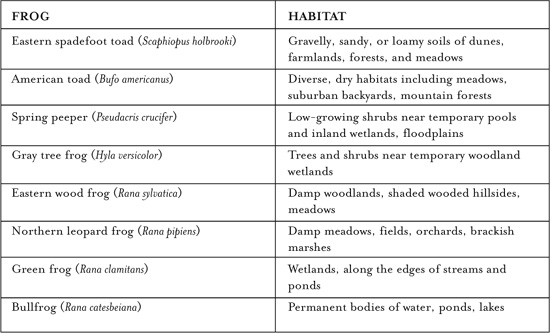
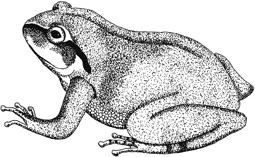
Pacific tree frog (Hyla regilla)
Rain and humidity bring out the frogs. If the night is windless, so much the better. Listen early in the spring for the calling that marks the beginning of the frogs’ annual trek from winter hideouts to their breeding places. Once this migration begins, you can expect the calling to continue into summer. Throughout this period you may see hundreds of frogs hopping across country roads because these roadways cut through the bogs, swamps, and other inland wetlands frogs use for breeding.
If you are not able to locate any frog ponds, ask the naturalists at a local nature center or museum or contact a local group such as the Audubon Society. Members of your local or regional herpetological society are also excellent resources.
The most accurate way to identify a frog call is to see the vocalist in action, but this is not always possible. A good substitute is to listen to recordings. With the help of modern technology, scientists have recorded frog calls in the field and you can use these at home. Sometimes your local library will have a tape or will get it if you request it.
The following table describes frog calls as compiled by field investigators. It is very difficult to put animal sounds into print, but perhaps this listing will help you.
There are those who say that frog calls lack melody, but all agree that the calls have character. Make a tape recording of frog calls to help you decide. …
It’s easy to tell frogs and toads from other amphibians such as salamanders and newts. What is not so easy is to separate frogs from their closer relatives, the toads, as the terms frog and toad often cause some confusion. It is easiest to make the distinction if you remember that frog is an umbrella term that includes all hopping or leaping amphibians, including toads. In other words, toads are a type of frog. …
Did you find the critter in a moist habitat such as a marsh, pond, or swampy area? Is it slim with smooth skin and long slender legs? Does it move quickly and leap great distances (greater than its body length)? Did you find it near others of its kind? If you have answered yes to these questions, you probably have caught a frog.
If you found the animal by itself in a drier habitat, such as woodland, meadow, or suburban yard, and thick, bumpy skin covers its plump body, it’s a safe guess that you have captured a toad. Prominent bony ridges on top of their heads (cranial crests) and conspicuous swelling behind their eyes (parotid glands) are other marks of toads.
Toads also are known for their sluggish movements, and with stubby legs they hop rather than leap as frogs do. Some frog species such as the gray tree frog have rough skin, which may lead you to believe they are toads, and other frog species may even look like toadsæbut their long legs and moist skin are good clues to their identity.
Almost everyone knows a frog when he sees one, and even small children can tell us that frogs have bulging eyes, wide mouths, and front legs shorter than their hind legs. What may not be so widely known is the way their tongues work. The long, sticky tongue of a frog is attached at the front of its mouth rather than the back, which allows it to do a remarkable thing. Like a fly fisherman casting his line, the frog can flip its tongue into the air and snare a passing insect with amazing speed and efficiency. …
Frogs have eardrums, or tympanic membranes, which are round and often a different color than the frog’s skin. Look for them behind the eyes. In some frog species you can distinguish the males from the females by the size of the eardrum relative to the eye. If the eardrum is larger than the eye, the frog is a male; if the eardrum is about the same size as the frog’s eye, then the frog is a female.
Look at the area behind the frog’s eyes. Do you see a conspicuous swelling behind each eye? These are the parotid glands, which toads use to produce toxic chemicals that are distasteful to predators. When threatened, a toad will lower its head to the level of its abdomen, so that when the predator attacks, it will grab the parotids, thus getting a mouthful of foul-tasting, toxic chemicals. Some frogs, such as the northern leopard frog, similarly secrete acidic fluids that irritate the mucous lining in the predator’s mouth….
Spadefoot toads are equipped with a special hard, crescent-shaped spade at the heel of each hind foot, an adaptation the toad uses for digging backwards into its burrow beneath the sandy soil. Young spadefoot toads must make their burrows in very soft, crumbly soil because their spades are soft.
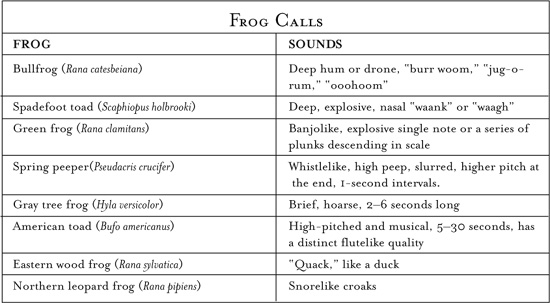
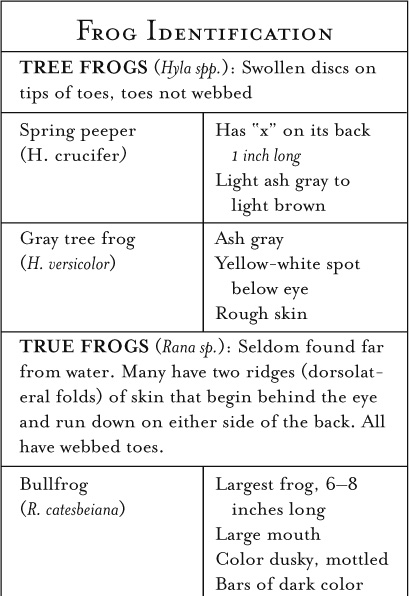
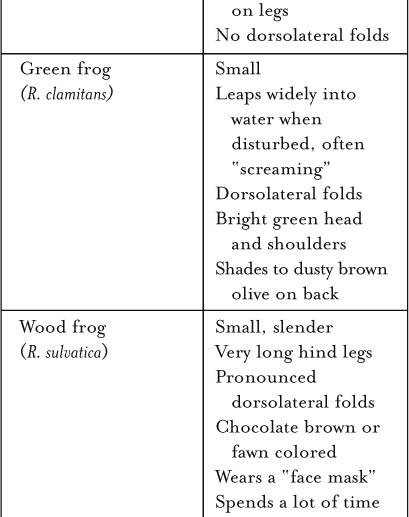
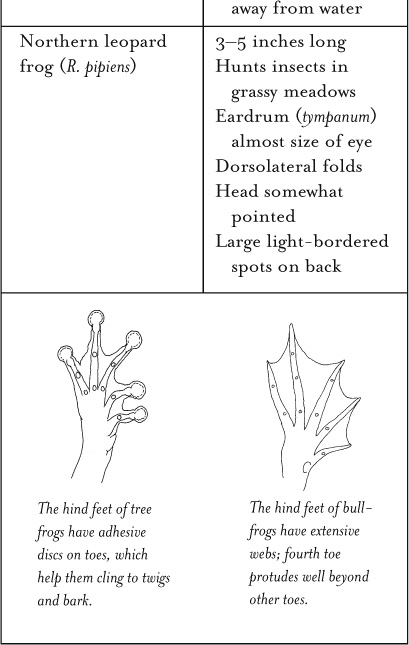
What is its general body shape? How is this an advantage for a creature that spends a great deal of time in the water?
Compare the frog skeleton with a human skeleton. You will notice that frogs don’t have ribs. Look for other differences and similarities.
One of the most rewarding aspects of frog watching is that you can learn to identify individuals. This kind of identification is important to scientists because it helps them find out such things about a frog as how far it roams, what its territorial boundaries are, and how long it lives. One investigator discovered that an American toad (Bufo americanus) lived in his backyard for nine years.
Although frogs and toads of the same species will look similar to each other, you can learn to recognize individual difference in color and pattern design. With practice you will know whether the frog in the garden on one night is the same frog that appears there on other occasions. To do this, you will need to make careful records of each of the frogs you find. Look carefully and record the pattern of color on each frog that you are observing. …
Frogs and toads eat invertebrates. Most of these are insects, but spiders, ants, and even earthworms have a place in the anuran diet. Thus, adult frogs and toads are predators. The prey need to be moving in order to activate the feeding response in frogs. You can observe this if you sit quietly beside a frog pond in the twilight. Watch carefully, and you may witness a frog capture a dragonfly or other large insect with its tongue.
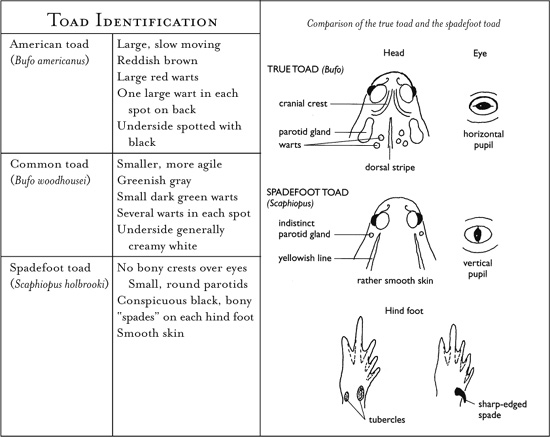
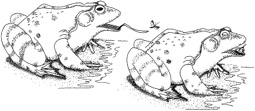
The frog has a long, sticky tongue attached to the front of the mouth. When an insect flies by, the frog’s tongue is propelled out for an instant to grab it.
Frogs and toads are also delicacies for many other animals. As you spend time around the frog “hot spots,” look for the creatures that prey on them. You may be on hand to see some food chains at work. Some frog predators include skunks, turtles, hognosed snakes, garter snakes, wading birds such as green herons, fish, and small mammals such as weasels, raccoons, and muskrats. Even domestic cats and dogs may help themselves to a frog or two.
While you are observing the food chains that involve frogs, look for those in which tadpoles are among the players. Newts, fish, water beetles, and water scorpions are a few tadpole predators. …
Calling is the most expensive activity in the life of an adult male frog in terms of the energy it requires. During the breeding season, male frogs call hundreds or thousands of times each night. The calling behavior of frogs can cost more than calories, as predators often use the calls to find tasty meals. The life of a frog is often the price a species pays for successful mating and the subsequent arrival of a new generation of frogs.
To produce calls, frogs take air into their lungs through their nostrils and pump the air rapidly back and forth from the lungs to a resonating chamber called the vocal sac. In its journey the air passes over the vocal cords, causing them to vibrate and produce the familiar “croak.” If you have ever tried to sleep near a frog pond, you know that croaking can continue throughout the night. When calling, a frog never needs to open its mouth. …
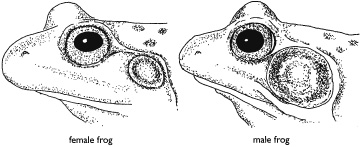
Frogs do not have exterior ears. The eardrum lies on the surface behind the frog’s eyes. Many times eardrums of males are larger than those of females.
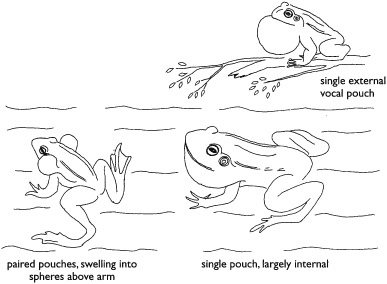
Three types of vocal sacs in frogs.
Since frogs live both in water and on land, their eyes must be able to function both when exposed to air and when submerged. The biggest problem for an eye in open air is that it might dry up; to prevent this, frogs have thick eyelids. A thin, transparent fold called the nictitating membrane passes over the eye from bottom to top and serves to moisten and protect the eye by washing it with a thin film of tearlike liquid secreted by glands in the eye. This liquid contains lysozyme (an enzyme found in tears and in egg whites), which protects the eyes from bacteria, viruses, and fungi that sneak in under the eyelids.
Frogs cannot turn their heads as we do. To compensate for this lack of neck motion, frogs’ bulging eyes provide them with a wide range of vision. This helps them find food and spot predators. You need only to sneak up on a frog to find out how well this design works. Frogs see well in twilight, and their night vision is extremely good. When frogs slip beneath the water’s surface, the nictitating membrane rises to cover the eye. As tadpoles, their eyes are suited to life in the winter. During this phase of their life, frog’s eyes more closely resemble those of fish than those of adult frogs.
Frogs have lightly colored underparts that contrast sharply with their darker tops. This is called countershading and is part of the frog’s camouflage. The light coloring along the underside of the frog makes it difficult for a deep-swimming predator looking toward the surface of the water to see its prey as it swims along the surface. It is equally difficult to see the dark upper surface of the frog against the dark background of the pond bottom when looking down through the water.
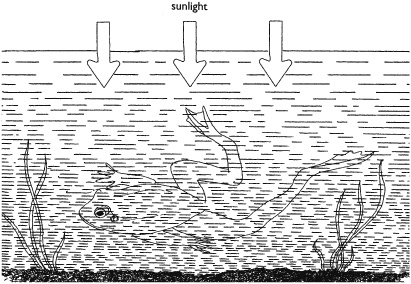
Viewed through the water, the dark dorsal surface of the frog is difficult to see against the dark bottom of the pond.
The mottled pattern found on frogs also serves to make the frog difficult to see because the irregular outline breaks up the form of the frog’s body. When looking for frogs, your eyes see the disruptive pattern as part of the vegetation in the frog’s habitat.
In the dark, our pupils become large black circles. Their size is controlled by the muscular irises, which contract as light diminishes. This process allows the maximum amount of available light to reach the rods of the retina; however, not all the light that passes through the pupil reaches the rods. Some of it is absorbed by surrounding tissues and is not available to illuminate our way in the dark.
Other critters have evolved different strategies for night vision. Owls, known for their nocturnal activity, have eyes that contain only rods, and their night vision is far superior to ours. The eyes of cats and water-bound dolphins contain many thousands more rods than our eyes do, and they see very well in the dark.
Another device developed by night-wandering animals is a layer of specialized cells called the tapetum that lies behind the retina. These mirrorlike cells reflect light back through the retina where it has a second chance to stimulate vision cells. You can see the tapetum when the eyes of skunks, raccoons, cats, and other animals are caught in the beam of light from a flashlight or the headlight of a car. Look for the red, yellow, or green eyeshine in our common night stalkers. You can learn to identify some animals by the color of their eye shine.
—Excerpted from Discover Nature in Water and Wetlands
Elizabeth P. Lawlor
Illustrations by Pat Archer
Much remains unknown about the origin of turtles. Scientists believe that their forebears may date as far back as 250 million years ago, to a primitive two-foot-long reptile. This ancestor carried a row of unfused bony plates over its back and tail. The plates eventually fused and spread out over the body to form a primitive, tubelike shell. This armor protected the animal from predators, as well as from extremes in temperature, but did not interfere with its stout walking legs. Over time, there were further changes in the reptilian ancestor, until it eventually looked much like the turtle we know today. Those early but fully formed turtles differed somewhat from those we see today, however. They were unable to pull their heads into the neck fold of skin, and they had tiny teeth, but they did possess a shell, the unmistakable hallmark of the turtle. Across eons of time, this basic characteristic has remained unchanged.
The new blueprint of the turtle’s shell shows several modifications in the animal’s body plan. Unlike the shell of the ancestral turtles, the bony upper shell, or carapace, is firmly attached to the flattened ribs that support it. The bony portion of the shell is now covered by close-fitting horny sections called scutes, which vary in color and design and aid in identifying different species of turtles. Like the rafters in the roof of a house, the pitch of the ribs determine the shape of the carapace; some turtle shells are dome shaped, while others are relatively flat.
The carapace and plastron are made of bony plates, or scutes, that fit closely together. The scutes are covered with a horny material that resembles our fingernails. This outer layer is sometimes shed or worn off, but as the turtle grows in size, it cannot shed its shell to accommodate the increasing size of the bones and other organs that underlie it. Instead, new material grows beneath the older horny material and covers the constantly enlarging bone of the shell. The new growth extends beyond the old shield and produces a ring around its edges. Like the concentric rings found in tree trunks, each ring on a shield represents a year of growth. Because the rings are easier to see on young turtles, the technique is most accurately used on turtles up to about the age of eight. In warm climates, growth continues throughout the year, so it is difficult to determine the age of the turtles.
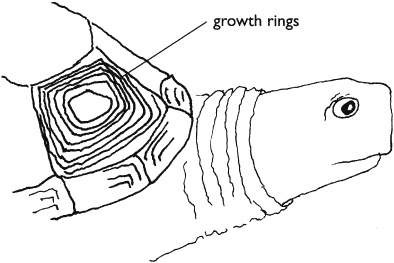
GENERIC TURTLE
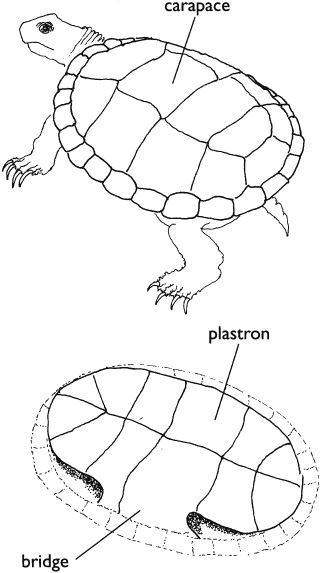
Turtles have an upper shell, or carapace, and a lower shell, or plastron, connected by a bony bridge.
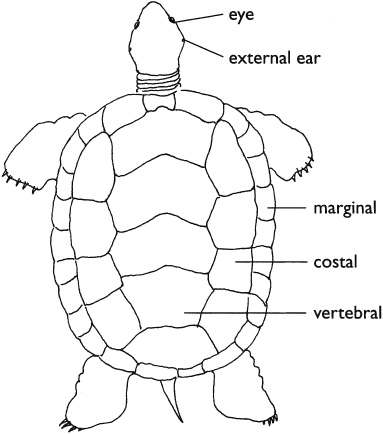
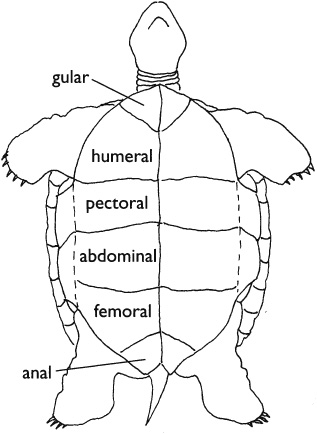
The development of the shell required additional modifications in turtle design. Turtles have lungs, but since the ribs are fused to the ridged shell, chest muscles like ours would not help them inhale and exhale air. Instead, they have three sets of special muscles that control their lungs. Two muscles, one on each side of the body, increase the size of the body cavity. This activity pulls air into the lungs. The air is forced out of the lungs by a third muscle pushing against the internal organs. When you observe a turtle, it may seem that muscles in the animal’s throat are involved in the breathing process, but the movement actually is a result of breathing, not the cause of it. Some turtles can survive without air for an amazing six months.
Turtles are toothless. Their jaws are covered with a horny material that forms a beak, which is a fine tool for tearing animal and plant material into bite-size pieces. If you watch turtles in captivity eat raw meat, you will see that this arrangement works well for them, and the absence of teeth is not a handicap.
What turtles eat depends primarily on where they live. Those that spend most of their time on land are generally herbivores, tending to eat only plant material. Some aquatic turtles feed on the plants or animals they find in the ponds and quiet streams where they live. Some dine on carrion, and others eat only small animals. Because turtles are slow moving and cannot chase their prey, they use a hide-and-pounce technique, which seems to work well for them. Snapping turtles have been known to grab unsuspecting ducks by their legs, drag them underwater, and make a meal of their captives.
A turtle’s skin is scaly and tough, helping prevent injury from attacks by predators or abrasion from rocks or other obstacles in the environment. There is a thin surface layer of cells that flakes off from time to time. This doesn’t cause the turtle’s color to change, however, because the cells that give the turtle its color lie deeper in the skin.
Most turtles mate in the spring, although some wait until summer, and a few even until autumn to perform this annual ritual. From early spring into autumn, you might see turtles crawling resolutely through woodlands, making their way along roadside ditches, or slogging through the muddy realm of ponds and swamps. When it comes to egg laying, turtles are not bound to fresh water to damp places, as are frogs and other amphibians. All turtles lay their eggs on land, even those that live in the water for the rest of the year. After mating, a female generally travels several hundred feet from the water in search of a suitable place to build a nest. When she finds the right spot, she will begin to dig a hole with her sharp-toed front feet. After excavating the surface layer of earth, which has been softened by spring rains, she will put her hind legs to work. Aided by sharp claws, a characteristic shared by all reptiles that have feet, she will laboriously dig a deeper inner hole that will cradle her eggs. When the hole is sufficiently deep, she deposits her eggs into it, covers the hole with excavated dirt, and ambles away. Large turtles have been known to deposit as many as fifty-two eggs in the nest, at a rate of two to three a minute. …
In all animals, heat production and regulation of internal temperature are essential for metabolic activity to take place. In birds and mammals, the source of body heat and the mechanism for control of that heat are internal, and the temperatures produced are stable within a given range. These animals are referred to as endotherms. In turtles, the body heat produced is conducted to the outside environment faster than they can replace it. Thus, the turtle’s internal body temperature is controlled mostly by external factors, such as the daily fluctuations of temperature and seasonal variations. Turtles and other animals that function this way are called ectotherms. (The terms “cold-blooded” and “warm-blooded” are old-fashioned and have fallen into disuse, since they do not provide a realistic idea of the metabolic differences between these two groups of animals.)
As the ambient temperature falls, turtles cannot generate enough body heat to maintain a constant internal temperature. Without a sufficiently high internal temperature, turtles cannot keep their vital processes, such as circulation, respiration, and digestion, working effectively. By the end of August, shorter days and cooler nights herald the coming of autumn. The turtles instinctively know that these events signal a cooling trend that leads to frigid winds and icy landscapes. They know that it’s time to prepare now for the cold season. As the temperature drops, turtles become increasingly inactive. When the temperature is about 50 degrees F., turtles will seek protection beneath piles of leaf litter. But when the temperature drops below freezing, many species, including painted, musk, and snapping turtles, return to the ponds that fed them during warmer weather and crawl beneath blankets of mud. While beneath the mud in a state of suspended animation, a turtle’s internal functions are slowed considerably. A painted turtle, for example, reduces its heartbeat to a mere one beat in ten minutes. In the reduced metabolic state brought on by the cold, turtles can go without food and air for a very long time.
Different turtle species have various ways of surviving the cold weather. Painted turtles that hatch from their eggs in early autumn remain throughout the winter about four inches below their earthen cover. They will surface sometime in May, after the spring sun has warmed the air. The eastern box turtle digs a den about three to four feet into the soil and remains there tightly closed inside its “box.”
During winter’s milder days, turtles are often seen sunning themselves on fallen logs, rocks, clumps of dead grass, and rafts of sphagnum moss, where they may pile up two or three deep. You can observe turtles basking even in the winter on warm days.
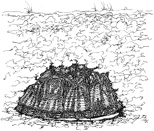
The eastern box turtle digs a den about 3 to 4 feet down and backfills with leaves and soil to cover itself. Snug in its shell, it is protected from the winter’s chilling cold.
Habitat destruction is a major threat to the welfare of turtles. Their habitats are being converted at an alarming rate into shopping malls, housing developments, and parking lots. The continued agricultural use of insecticides and pesticides is responsible for further damage to those places that turtles call home. Several species are currently on the protected list….
Wood and Pond Turtles. These turtles are adapted for living both on land and in the water. Their legs are strong enough for walking on land, and they have webbed toes that make them effective swimmers. Their cumbersome shells do not interfere with their ability to swim. They are omnivores, eating both plant and animal material.
Land Tortoises. These turtles have heavy, bulky shells and move more slowly than wood and pond turtles. Their front legs are adapted for shoveling soil and sand aside. The front edge of the bottom shell is curved upward so that it doesn’t get hung up on obstacles but instead helps the turtles slide up and over obstacles, like the upcurved front of a sled. With their heavy armor, they don’t need to run from predators, and this, combined with their diet of plant materials, makes life in the slow lane possible.
Soft-shelled Turtles. These turtles seldom leave their watery world, where they live partly buried in the mud. The soft-shelled turtle has a thin, leathery shell that resembles a pancake and a flat body adapted to wiggling into the mud for protection, leaving only the head projecting. This turtle is colored to look like mud or muddy stones.
The ideal way to observe a wild creature is to avoid anything that interferes with it or disturbs its normal routine. When you are observing turtles, be very careful to do no harm, both to the creature and to its habitat. Some turtles, like the box turtle, withdraw into their shells if you pick them up, but others have long, agile necks and may reach back to bite you, so be careful both for your sake and for the turtle’s.

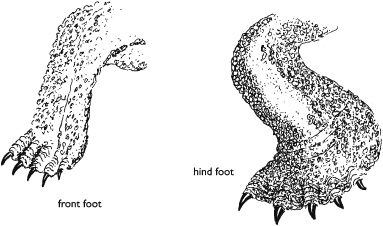
The webbing on the turtle’s hind feet is more highly developed.
Since many turtle species tend to retract their legs, head, and tail when picked up, this is a good time to look at the suit of armor it wears. The top shell, or carapace, derived from the Spanish word for “shield,” adheres to the turtle’s backbone and ribs. In many turtles, this shell has a dome shape. The steepness of the dome varies and is dependent on the curve of the turtle’s ribs that lie beneath it. In some species, the carapace is almost flat. In others, it is high and boxy. The bottom shell, which adheres to the breastbone, is called the plastron, from the Italian word for “breastplate,” a piece of armor that soldiers strapped across the chest to deflect arrows and blows from swords. …
The diagrams of the box turtle and the snapping turtle illustrate two extremes in plastron design. The crosslike shape of the snapping turtle’s lower shell allows greater freedom of movement, but protection of limbs, head, and neck from below has been sacrificed. The snapping turtle’s head, neck, and limbs are extremely agile, and it can be dangerous unless you are very careful and know how to handle it. In contrast, the box turtle has given up agility for complete protection from its shell.
People often think they see a snake in a pond, only to find out they were looking at the head and neck of a turtle. …
The outline and illustrations below include some of our more common turtles and will help you identify the turtles you find.
1. SPOTTED TURTLE
(Clemmys guttata)
Habitat. Shallow ponds, marshes, small woodland streams, and rain-filled pools in wooded areas, along dirt roads, and in rain-soaked pastures.
Field marks. The blue-black to black top shell is smooth and low. It’s handsomely decorated with randomly placed lemon yellow spots. The polkadot pattern differs for each individual. Head and limbs are similarly spotted but are gray to black. The dark pigment melanin increases with age, so the top shells of older turtles are frequently spotless. The underside edges of the upper shell are marked with yellow. The female has a yellow chin and orange eyes; the male has a tan chin and brown eyes. The male’s tail is almost twice as long as the female’s tail, and the male’s carapace grows to about five inches.
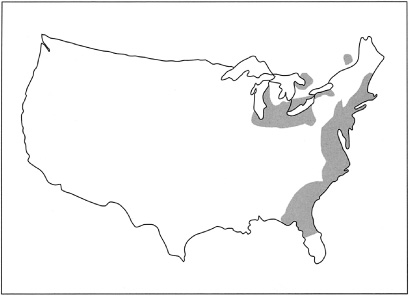
Range of the painted turtle.

Spotted turtle (Clemmys guttata), 3½ to 5 inches.
Behavior. Look for spotted turtles during the daylight hours, when they sun themselves on floating logs, rocks, or clumps of grasses and reeds near water’s edge. They may bask in the company of painted turtles. You may see them hunting for food as well. These turtles don’t engage in aimless wandering. With darkness, they burrow under vegetation, into muddy bottoms of wetlands, where they remain until dawn.
Food preferences. Feed on grasses and green algae underwater. Also eat live or dead aquatic insect larvae, small crustaceans, snails, and tadpoles.
Predators. Bald eagles, skunks, and raccoons.
Breeding and nesting. Early March, when water temperatures reach 46 degrees F. and the air reaches 54 degrees F. Dry, sandy fields and the margins of hayfields are choice nest spots. Vegetation such as bluestem grasses or sweet ferns generally shelters a nest.
Other remarks. Spotted turtles have keen senses of smell and sight. These turtles may live into their twenties.
2. PAINTED TURTLE
(Chrysemys picta)
Habitat. Permanent shallow waters with muddy bottoms and plenty of vegetation, such as partially overgrown ponds.
Field marks. A handsome small turtle with a flat top shell that is olive with yellow or red markings along its edge. The carapace colors blend with the patterns and colors of shade, plants, and earth, camouflaging the turtle, but you may see the scarlet rim of the shells when it dips beneath the surface of the pond. The plates on the upper shell sides are bordered with yellow. The lower shell is bright yellow-orange. The head and neck are adorned with yellow streaks behind the eye. Yellow stripes of uniform length become red as they extend to throat. Limbs and tail are also speckled and streaked with red. There are four subspecies of the painted turtle, each of which sports its own characteristic pattern of red and yellow. Adults measure six to eight inches in length.
Behavior. In the northern part of their range, look for them from March into November. They often are seen basking on logs, rocks, and amid clumps of floating grasses early in the morning and again in the afternoon. You may also be able to see these turtles swimming beneath winter ice. Farther south, they emerge sooner and begin hibernation later. Be careful if you want to observe them for details; the slightest movement may send them spilling into the water and out of sight. At night they sleep on the muddy sheets that line their ponds. They don’t ever stray far from their watery homes.
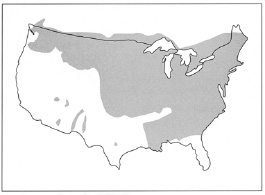
Range of the painted turtle.
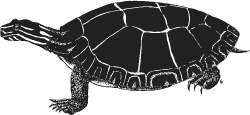
Painted turtle (Chrysemys picta), 6 to 8 inches.
Food preferences. Animal or plant material of any type, living or dead, including earthworms, leeches, slugs, snails, crayfish, spiders, water striders, beetles, dragonflies, springtails, damselflies, and dead fish. Forage in the morning and late in the afternoon, along the bottom of ponds and among algae. Eat underwater and seem unable to swallow their food if out of water.
Predators. Primarily raccoons, but chipmunks, skunks, badgers, foxes, garter snakes, fish crows, and humans also destroy nests.
Breeding and nesting. Nests may be found along the tree-lined margins of fields, a few feet to several yards away from the tree line, along roadsides, and in gravel pits. Only females leave the pond, and they do so when ready to lay their eggs.
Other remarks. One of the most numerous turtles in North America. One reason for its success is that it is able to live in ponds close to our homes in the suburbs and in cities. May live some twenty years.
3. EASTERN BOX TURTLE
(Terrapene carolina)
Habitat. Primarily woodland turtles, you may find them in neglected pastureland and marshy meadows. Although considered a land turtle, they will take to water. They will soak in mud for hours to wash away the dust and to escape hot summer air.
Field marks. Unique hinged lower shell that can be closed tightly by strong muscles against the upper shell, protecting the turtle against all predators. The seal is so tight that even a thin knife blade cannot be wedged between the shells when they are closed. Easily recognized high, domed, brownish top shell with yellow or orange rays, and spots or bars in each plate. Tan to brown lower shell that may or may not be patterned. Black to reddish skin streaked or spotted with red, yellow, or orange. There are four subspecies that differ somewhat in color. Males can be distinguished from females by eye coloræred or pink in males, and generally brown, but sometimes purple or gray, in females. Adults measure four to six inches in length.

Range of the eastern box turtle.
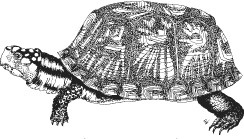
Eastern box turtle (Terrapene Carolina), 4 to 6 inches.
Behavior. From April through October, you may find them sunning themselves at the edges of fields or roads or in forest groves. They avoid the heat of the day by hiding under logs, in clumps of decaying leaves, vacant mammal burrows, or holes they dig into the mud. Box turtles have fairly well-defined home territories that are usually less than 750 square feet, which they wander freely. Because they have a strong sense of direction, they seldom get lost.
Food preferences. Forage on land or in shallow water. The young are carnivorous, but as they grow older, box turtles prefer a more vegetarian diet, including mushrooms, blueberries, elderberries, wild grapes, strawberries, tomatoes, mayapples, wintergreen, and mosses. Blackberries are their favorite food, and box turtles have been known to gorge on them. Animal foods include insects, snails, slugs, earthworms, and spiders.
Predators. Badgers, foxes, skunks, barn owls, crows, and snakes destroy many nests and feed on young. Adults are often attacked by carnivores such as raccoons, skunks, coyotes, and dogs. Box turtles found with mutilated legs are usually victims of such attacks.
Breeding and nesting. Nests may be found in sandy fields and meadows, cultivated gardens, along roadsides, and in ditches. The female digs a flask-shaped nest in three to five hours, lays up to eight elliptical eggs, and covers them with the excavated dirt.
Other remarks. Can live more than 120 years and are the longest-lived vertebrates in North America.
4. SNAPPING TURTLE
(Chelydra serpentina)
Habitat. Almost every kind of shallow freshwater habitat, especially slow-moving streams with soft, muddy bottoms. Although these are water turtles, you have a good chance of finding one on land, and during the early spring, you might see one roaming through a roadside ditch, along a streambank, or in a salt marsh.
Field marks. A snapping turtle looks like a prehistoric animal that wandered into present geologic time. It has a large, pointed head and a strong beak that is excellent for tearing meat. Its tail is as long as or longer than the carapace and has three rows of bumps down its length. The huge, bumpy top shell is brown or deep gray to black, providing camouflage, and each plate is generally patterned with radiating lines. The rear of the top shell is notched. The cross-shaped bottom shell is much smaller than the top shell and does not protect an overturned turtle. Webbed toes and heavy claws indicate a good swimmer and efficient digger. The snapper’s design is fitting for the life of a bottom dweller. Snappers generally weigh twenty-five to thirty pounds, although adults can reach forty pounds and a length of three feet.
Behavior. The snapper spends most of its time on the bottom of a pond or buried in the mud, with only its eyes and the tip of its nose visible. It must extend its neck to raise its nostrils above the water from time to time to breathe. The snapper may also hide in tangles of roots and under tree stumps. It can anchor itself to an object by wrapping its strong tail around it. A swift walker, it can also lunge and jump. The snapping turtle can move its head with surprising speed, and its sharp beak tears very wellæa compensation for the loss of protection from its abbreviated shells. It is aggressive on land but docile in the water.
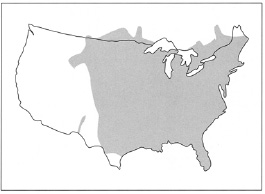
Range of the snapping turtle.
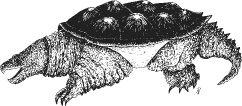
Snapping turtle (Chelydra serpentina), 18 to 32 inches.
Food preferences. Plants and animals, including salamanders, small turtles, frogs, snakes, and birds. Forages along weedy and muddy bottoms, where it eats almost anything its powerful hooked jaws can rip into bite-size pieces.
Predators. Hognose snakes, mink, crows, bears, foxes, wolves, and raccoons eat snapper eggs. Hatchlings and young turtles provide food for herons, egrets, bitterns, shrikes, large hawks, bald eagles, bullfrogs, and water snakes.
Breeding and nesting. Nests are dug in loose, sandy soil or loam along railroads, roadside ditches, and beaches. Sometimes make their nests in beaver lodges. Females lay their eggs at night.
Other remarks. Do not treat these fast-moving turtles casually. When handled improperly, they can inflict serious wounds. It is best to leave them alone.
5. WOOD TURTLE
(Clemmys insculpta)
Habitat. The wood turtle wanders far from water in late spring and summer, when you may find them lumbering through pastures and woodlands. In early spring and in the autumn, the turtles prefer the wetter environs of swamps, brooks, and ponds, because they spend the winter in the muddy bottoms of these damp places.
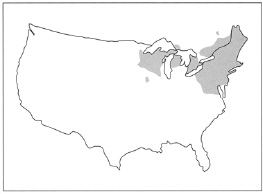
Range of the wood turtle.
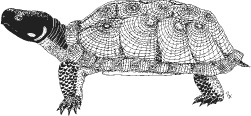
Wood turtle (Clemmys insculpta), 5½ to 7½ inches.
Field marks. The roughly sculptured concentric ridges on the plates of the gray-brown carapace make this turtle easy to identify. Head and feet are rusty brown to black, and the limbs, neck, and tail are a muted brick red—ideal for camouflaging the turtle among dead leaves and grasses. The carapace of the adult wood turtle measures about six and one-half inches.
Behavior. Active during daylight from April to November. In spring and summer, these turtles travel far from water to pastures, woodlands, and upland fields. They are good swimmers. Like other turtles, wood turtles bask, but they usually engage in the activity individually; rarely will you find more than one wood turtle basking together. When cold weather comes, they hibernate in muskrat burrows, snuggling beneath the banks of streams and ponds, although they have been seen swimming under the ice during the winter.
Food preferences. When on land, eat the same fare as ground-nesting birds, including strawberries, blackberries, and leaves of various wild-flowers, but seem to prefer mushrooms. In water, eat aquatic insects and animals.
Predators. Raccoons, rodents, and striped skunks eat wood turtle eggs. Feral cats, dogs, and opossums feed on young wood turtles.
Breeding and nesting. The nesting season is from May to July. Well-drained, moist sand or soil provides good nest material. Female digs a hollow in fields, along sunny roadsides, or in gravelly ditches, where she deposits about twelve eggs.
6. MUSK TURTLE
(Sternotherus odoratus)
Habitat. Shallow ponds with clear water. Spends an inactive winter at the bottom of a pond or in a muskrat den. Comes on land only to lay eggs. In general, keeps a low profile.
Field marks. Highly arched, smooth, brown carapace provides good camouflage for a turtle that spends a great deal of time on muddy pond bottoms. The carapace is frequently covered with algae, which makes it difficult to distinguish the turtle from rocks or chunks of wood on the muddy bottom. Two yellow lines, one above and one below the eye, extend along each side of the head and neck. Mature musk turtles measure about four to five inches in length.
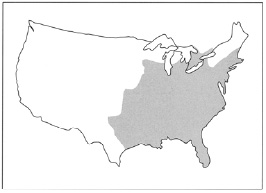
Range of the musk turtle.
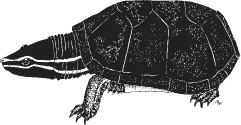
Musk turtle (Sternotherus odoratus), 4 to 5 inches.
Behavior. Most active after sunset. Live and feed on the bottoms of ponds, reservoirs, lakes, and slow-running streams. Musk turtles snap, and with their strong beaks, they can inflict a serious wound.
Food preferences. Small fish, worms, insects, and tadpoles.
Predators. Raccoons, foxes, and skunks eat the eggs. Snakes, frogs, herons, and fish feed on hatchlings.
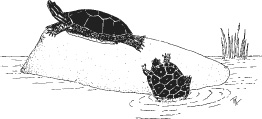
An important part of the day for many turtles is the time spent basking in the sun.
Breeding and nesting. Visit land in late June only to lay their eggs. Egg laying in May and June seems to be a haphazard affair. The females deposit their eggs in shallow nests on the surface of the ground, in leaf litter, tucked into rotting logs, or in muskrat lodges.
Other remarks. The musk turtle is nicknamed stinkpot, for the odor that is secreted from musk glands near the base of the limbs.
—Excerpted from Discover Nature in Water and Wetlands
Animals rarely are as threatening to the survivor as the rest of the environment. Common sense tells the survivor to avoid encounters with lions, bears, and other large or dangerous animals. You should also avoid large grazing animals with horns, hooves, and great weight. Your actions may prevent unexpected meetings. Move carefully through their environment. Do not attract large predators by leaving food lying around your camp. Carefully survey the scene before entering water or forests.
Smaller animals actually present more of a threat to the survivor than large animals. To compensate for their size, nature has given many small animals weapons such as fangs and stingers to defend themselves. Each year, a few people are bitten by sharks, mauled by alligators, and attacked by bears. Most of these incidents were in some way the victim’s fault. However, each year more victims die from bites by relatively small venomous snakes than by large dangerous animals. Even more victims die from allergic reactions to bee stings. For this reason, we will pay more attention to smaller and potentially more dangerous creatures. These are the animals you are more likely to meet as you unwittingly move into their habitat, or they slip into your environment unnoticed.
Keeping a level head and an awareness of your surroundings will keep you alive if you use a few simple safety procedures. Do not let curiosity and carelessness kill or injure you.
—From Survival (U.S. Army Field Manual 21–76)
U.S. Army
There are no infallible rules for expedient identification of poisonous snakes in the field, because the guidelines all require close observation or manipulation of the snake’s body. The best strategy is to leave all snakes alone. Where snakes are plentiful and poisonous species are present, the risk of their bites negates their food value. Apply the following safety rules when traveling in areas where there are poisonous snakes:
• Walk carefully and watch where you step. Step onto logs rather than over them before looking and moving on.
• Look closely when picking fruit or moving around water.
• Do not tease, molest, or harass snakes. Snakes cannot close their eyes. Therefore, you cannot tell if they are asleep. Some snakes, such as mambas, cobras, and bush-masters, will attack aggressively when cornered or guarding a nest.
• Use sticks to turn logs and rocks.
• Wear proper footgear, particularly at night.
• Carefully check bedding, shelter, and clothing.
• Be calm when you encounter serpents. Snakes cannot hear and you can occasionally surprise them when they are sleeping or sunning. Normally, they will flee if given the opportunity.
• Use extreme care if you must kill snakes for food or safety. Although it is not common, warm, sleeping human bodies occasionally attract snakes.
The polar regions are free of snakes due to their inhospitable environments. Other areas considered to be free of poisonous snakes are New Zealand, Cuba, Haiti, Jamaica, Puerto Rico, Ireland, Polynesia, and Hawaii.
• American Copperhead (Agkistrodon contortrix)
• Bushmaster (Lachesis mutus)
• Coral snake (Micrurus fulvius)
• Cottonmouth (Agkistrodon piscivorus)
• Fer-de-lance (Bothrops atrox)
• Rattlesnake (Crotalus species)
• Common adder (Vipers berus)
• Pallas’ viper (Agkistrodon halys)
• Boomslang (Dispholidus typus)
• Cobra (Naja species)
• Gaboon viper (Bitis gabonica)
• Green tree pit viper (Trimeresurus gramineus)
• Habu pit viper (Trimeresurus flavoviridis)
• Krait (Bungarus caeruleus)
• Malayan pit viper (Callaselasma rhodostoma)
• Mamba (Dendraspis species)
• Puff adder (Bitis arietans)
• Rhinoceros viper (Bitis nasicornis)
• Russell’s viper (Vipera russellii)
• Sand viper (Cerastes vipera)
• Saw-scaled viper (Echis carinatus)
• Wagler’s pit viper (Trimeresurus wagleri)
• Death adder (Acanthophis antarcticus)
• Taipan (Oxyuranus scutellatus)
• Tiger snake (Notechis scutatus)
• Yellow-bellied sea snake (Pelamis platurus)
Snakes are widely distributed. They are found in all tropical, subtropical, and most temperate regions. Some species of snakes have specialized glands that contain a toxic venom and long hollow fangs to inject their venom.
Although venomous snakes use their venom to secure food, they also use it for self-defense. Human accidents occur when you don’t see or hear the snake, when you step on them, or when you walk too close to them.
Follow these simple rules to reduce the chance of accidental snakebite:
• Don’t sleep next to brush, tall grass, large boulders, or trees. They provide hiding places for snakes. Place your sleeping bag in a clearing. Use mosquito netting tucked well under the bag. This netting should provide a good barrier.
• Don’t put your hands into dark places, such as rock crevices, heavy brush, or hollow logs, without first investigating.
• Don’t step over a fallen tree. Step on the log and look to see if there is a snake resting on the other side.
• Don’t walk through heavy brush or tall grass without looking down. Look where you are walking.
• Don’t pick up any snake unless you are absolutely positive it is not venomous.
• Don’t pick up freshly killed snakes without first severing the head. The nervous system may still be active and a dead snake can deliver a bite.


The proteroglypha have, in front of the upper jaw and preceding the ordinary teeth, permanently erect fangs. These fangs are called fixed fangs.
The solenoglypha have erectile fangs; that is, fangs they can raise to an erect position. These fangs are called folded fangs.
The fixed-fang snakes (proteroglypha) usually have neurotoxic venoms. These venoms affect the nervous system, making the victim unable to breathe.
The folded-fang snakes (solenoglypha) usually have hemotoxic venoms. These venoms affect the circulatory system, destroying blood cells, damaging skin tissues, and causing internal hemorrhaging.
Remember, however, that most poisonous snakes have both neurotoxic and hemotoxic venom. Usually one type of venom in the snake is dominant and the other is weak.
No single characteristic distinguishes a poisonous snake from a harmless one except the presence of poison fangs and glands. Only in dead specimens can you determine the presence of these fangs and glands without danger.
VIPERIDAE
The viperidae, or true vipers, usually have thick bodies and heads that are much wider than their necks. However, there are many different sizes, markings, and colorations.
This snake group has developed a highly sophisticated means for delivering venom. They have long, hollow fangs that perform like hypodermic needles. They deliver their venom deep into the wound.
The fangs of this group of snakes are movable. These snakes fold their fangs into the roof of their mouths. When they strike, their fangs come forward, stabbing the victim. The snake controls the movement of its fangs; fang movement is not automatic. The venom is usually hemotoxic. There are, however, several species that have large quantities of neurotoxic elements, thus making them even more dangerous. The vipers are responsible for many human fatalities around the world.
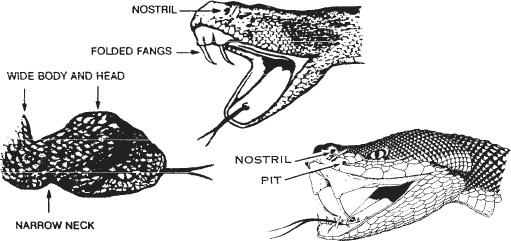
Positive identification of vipers.
CROTALIDAE
The crotalids, or pit vipers, may be either slender or thick-bodied. Their heads are usually much wider than their necks. These snakes take their name from the deep pit located between the eye and the nostril. They are commonly brown with dark blotches, though some kinds are green.
Rattlesnakes, copperheads, cottonmouths, and several species of dangerous snakes from Central and South America, Asia, China, and India fall into the pit viper group. The pit is a highly sensitive organ capable of picking up the slightest temperature variance. Most pit vipers are nocturnal. They hunt for food at night with the aid of these specialized pits that let them locate prey in total darkness. Rattlesnakes are the only pit vipers that possess a rattle at the tip of the tail.
India has about 12 species of these snakes. You find them in trees or on the ground in all types of terrain. The tree snakes are slender; the ground snakes are heavy-bodied. All are dangerous.
China has a pit viper similar to the cottonmouth found in North America. You find it in the rocky areas of the remote mountains of South China. It reaches a length of 1.4 meters but is not vicious unless irritated. You can also find a small pit viper, about 45 centimeters long, on the plains of eastern China. It is too small to be dangerous to a man wearing shoes.
There are about 27 species of rattlesnakes in the United States and Mexico. They vary in color and may or may not have spots or blotches. Some are small while others, such as the diamondbacks, may grow to 2.5 meters long.
There are five kinds of rattlesnakes in Central and South America, but only the tropical rattlesnake is widely distributed. The rattle on the tip of the tail is sufficient identification for a rattlesnake.
Most will try to escape without a fight when approached, but there is always a chance one will strike at a passerby. They do not always give a warning; they may strike first and rattle afterwards or not at all.
The genus Trimeresurus is a subgroup of the crotalidae. These are Asian pit vipers. These pit vipers are normally tree-loving snakes with a few species living on the ground. They basically have the same characteristics of the crotalidae—slender build and very dangerous. Their bites usually are on the upper extremities—head, neck, and shoulders. Their venom is largely hemotoxic.
ELAPIDAE
A group of highly dangerous snakes with powerful neurotoxic venom that affects the nervous system, causing respiratory paralysis. Included in this family are coral snakes, cobras, mambas, and all the Australian venomous snakes. The coral snake is small and has caused human fatalities. The Australian death adder, tiger, taipan, and king brown snakes are among the most venomous in the world, causing many human fatalities.
Only by examining a dead snake can you positively determine if it is a cobra or a near relative. On cobras, kraits, and coral snakes, the third scale on the upper lip touches both the nostril scale and the eye. The krait also has a row of enlarged scales down its ridged back.
You can find the cobras of Africa and the Near East in almost any habitat. One kind may live in or near water, another in trees. Some are aggressive and savage. The distance a cobra can strike in a forward direction is equal to the distance its head is raised above the ground. Some cobras, however, can spit venom a distance of 3 to 3.5 meters. This venom is harmless unless it gets into your eyes; then it may cause blindness if not washed out immediately. Poking around in holes and rock piles is dangerous because of the chance of encountering a spitting cobra.
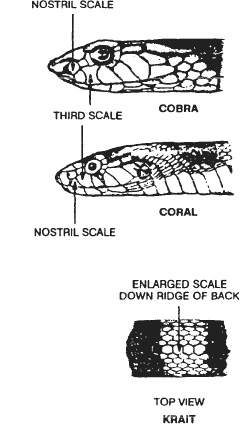
Positive identification of cobras, kraits, and coral snakes.
LATICAUDINAE AND HYDROPHIDAE
A subfamily of elapidae, these snakes are specialized in that they found a better environment in the oceans. Why they are in the oceans is not clear to science.
Sea snakes differ in appearance from other snakes in that they have an oarlike tail to aid in swimming. Some species of sea snakes have venom several times more toxic than the cobra’s. Because of their marine environment, sea snakes seldom come in contact with humans. The exceptions are fisherman who capture these dangerous snakes in fish nets and scuba divers who swim in waters where sea snakes are found.
There are many species of sea snakes. They vary greatly in color and shape. Their scales distinguish them from eels that have no scales.
Sea snakes occur in salt water along the coasts throughout the Pacific. There are also sea snakes on the east coast of Africa and in the Persian Gulf. There are no sea snakes in the Atlantic Ocean.
There is no need to fear sea snakes. They have not been known to attack a man swimming. Fishermen occasionally get bit by a sea snake caught in a net. The bite is dangerous.
COLUBRIDAE
The largest group of snakes worldwide. In this family there are species that are rear-fanged; however, most are completely harmless to man.
They have a venom-producing gland and enlarged, grooved rear fangs that allow venom to flow into the wound. The inefficient venom apparatus and the specialized venom is effective on cold-blooded animals (such as frogs and lizards) but not considered a threat to human life. The boomslang and the twig snake of Africa have, however, caused human deaths.
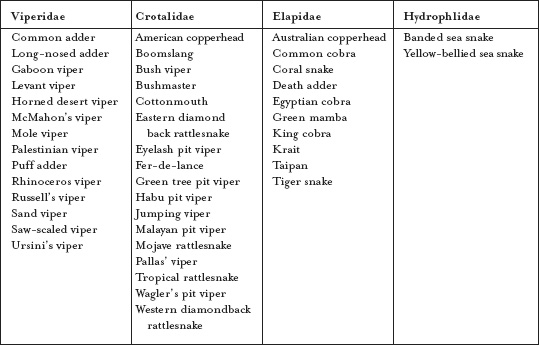
AMERICAN COPPERHEAD
Agkistrodon contortrix
Description. Chestnut color dominates overall, with darker crossbands of rich browns that become narrower on top and widen at the bottom. The top of the head is a coppery color.
Characteristic. Very common over much of its range, with a natural camouflage ability to blend in the environment. Copperheads are rather quiet and inoffensive in disposition but will defend themselves vigorously. Bites occur when the snakes are stepped on or when a victim is lying next to one. A copperhead lying on a bed of dead leaves becomes invisible. Its venom is hemotoxic.
Habitat. Found in wooded and rocky areas and mountainous regions.
Length. Average 60 centimeters, maximum 120 centimeters.
Distribution. Eastern Gulf States, Texas, Arkansas, Maryland, North Florida, Illinois, Oklahoma, Kansas, Ohio, New York, Alabama, Tennessee, and Massachusetts.
BUSHMASTER
Lachesis mutus
Description. The body hue is rather pale brown or pinkish, with a series of large bold dark brown or black blotches extending along the body. Its scales are extremely rough.
Characteristics. The world’s largest pit viper has a bad reputation. This huge venomous snake is not common anywhere in its range. It lives in remote and isolated habitats and is largely nocturnal in its feeding habits; it seldom bites anyone, so few bites are recorded. A bite from one would indeed be very serious and fatal if medical aid was not immediately available. Usually, the bites occur in remote, dense jungles, many kilometers and several hours or even days away from medical help. Bushmaster fangs are long. In large bushmasters, they can measure 3.8 centimeters. Its venom is a powerful hemotoxin.

Bushmaster.
Habitat. Found chiefly in tropical forests in their range.
Length. Average 2.1 meters, maximum 3.7 meters.
Distribution. Nicaragua, Costa Rica, Panama, Trinidad, and Brazil.
CORAL SNAKE
Micurus fulvius
Description. Beautifully marked with bright blacks, reds, and yellows. To identify the species, remember that when red touches yellow it is a coral snake.
Characteristics. Common over range, but secretive in its habits, therefore seldom seen. It has short fanges that are fixed in an erect position. It often chews to release its venom into a wound. Its venom is very powerful. The venom is neurotoxic, causing respiratory paralysis in the victim, who succumbs to suffocation.
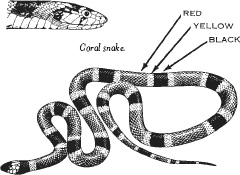
Habitat. Found in a variety of habitats including wooded areas, swamps, palmetto and scrub areas. Coral snakes often venture into residential locations.
Length. Average 60 centimeters, maximum 115 centimeters.
Distribution. Southeast North Carolina, Gulf States, west central Mississippi, Florida, Florida Keys, and west to Texas. Another genus of coral snake is found in Arizona. Coral snakes are also found throughout Central and most South America.
COTTONMOUTH
Agkistrodon piscivorus
Description. Colors are variable. Adults are uniformly olive brown or black. The young and subadults are strongly crossbanded with dark brown.
Characteristics. These dangerous semiaquatic snakes closely resemble harmless water snakes that have the same habitat. Therefore, it is best to leave all water snakes alone. Cottonmouths often stand their ground. An aroused cotton-mouth will draw its head close to its body and open its mouth showing its white interior. Cottonmouth venom is hemotoxic and potent. Bites are prone to gangrene.
Habitat. Found in swamps, lakes, rivers, and ditches.
Length. Average 90 centimeters, maximum 1.8 meters.
Distribution. Southeast Virginia, west central Alabama, south Georgia, Illinois, east central Kentucky, south central Oklahoma, Texas, North and South Carolina, Florida, and the Florida Keys.
EASTERN DIAMONDBACK RATTLESNAKE
Crotalus adamanteus
Description. Diamonds are dark brown or black, outlined by a row of cream or yellowish scales. Ground color is olive to brown.
Characteristics. The largest venomous snake in the United States. Large individual snakes can have fangs that measure 2.5 centimeters in a straight line. This species has a sullen disposition, ready to defend itself when threatened. Its venom is potent and hemotoxic, causing great pain and damage to tissue.
Habitat. Found in palmettos and scrubs, swamps, pine woods, and flatwoods. It has been observed swimming many miles out in the Gulf of Mexico, reaching some of the islands off the Florida coast.
Length. Average 1.4 meters, maximum 2.4 meters.
Distribution. Coastal areas of North Carolina, South Carolina, Louisiana, Florida, and the Florida Keys.
EYELASH PIT VIPER
Bothrops schlegeli
Description. Identified by several spiny scales over each eye. Color is highly variable, from bright yellow over its entire body to reddish-yellow spots throughout the body.
Characteristics. Arboreal snake that seldom comes to the ground. It feels more secure in low-hanging trees where it looks for tree frogs and birds. It is a dangerous species because most of its bites occur on the upper extremities. It has an irritable disposition. It will strike with little provocation. Its venom is hemotoxic, causing severe tissue damage. Deaths have occurred from the bites of these snakes.
Habitat. Tree-loving species found in rain forests; common on plantations and in palm trees.
Length. Average 45 centimeters, maximum 75 centimeters.
Distribution. Southern Mexico, throughout Central America, Columbia, Ecuador, and Venezuela.
FER-DE-LANCE
Bothrops atrox
These are several closely related species in this group. All are very dangerous to man.
Description. Variable coloration, from gray to olive, brown, or reddish, with dark triangles edged with light scales. Triangles are narrow at the top and wide at the bottom.
Characteristics. This highly dangerous snake is responsible for a high mortality rate. It has an irritable disposition, ready to strike with little provocation. The female fer-de-lance is highly prolific, producing up to 60 young born with a dangerous bite. The venom of this species is hemotoxic, painful, and hemorrhagic (causing profuse internal bleeding). The venom causes massive tissue destruction.
Habitat. Found on cultivated land and farms, often entering houses in search of rodents.
Length. Average 1.4 meters, maximum 2.4 meters.
Distribution. Southern Mexico, throughout Central and South America.
JUMPING VIPER
Bothrops nummifer
Description. It has a stocky body. Its ground color varies from brown to gray and it has dark brown or black dorsal blotches. It has no pattern on its head.
Characteristics. It is chiefly a nocturnal snake. It comes out in the early evening hours to feed on lizards, rodents, and frogs. As the name implies, this species can strike with force as it actually leaves the ground. Its venom is hemotoxic. Humans have died from the bites inflicted by large jumping vipers. They often hide under fallen logs and piles of leaves and are difficult to see.
Habitat. Found in rain forests, on plantations, and on wooded hillsides.
Length. Average 60 centimeters, maximum 120 centimeter.
Distribution. Southern Mexico, Honduras, Guatemala, Costa Rica, Panama, and El Salvador.
MOJAVE RATTLESNAKE
Crotalus scutulatus
Description. This snake’s entire body is a pallid or sandy odor with darker diamond-shaped markings bordered by lighter-colored scales and black bands around the tail.
Characteristics. Although this rattlesnake is of moderate size, its bite is very serious. Its venom has quantities of neurotoxic elements that affect the central nervous system. Deaths have resulted from this snake’s bite.
Habitat. Found in arid regions, deserts, and rocky hillsides from sea level to 2400-meter elevations.
Length. Average 75 centimeters, maximum 1.2 meters.
Distribution. Mojave Desert in California, Nevada, southwest Arizona, and Texas into Mexico.
TROPICAL RATTLESNAKE
Crotalus terrificus
Description. Coloration is light to dark brown with a series of darker rhombs or diamonds bordered by a buff color.
Characteristics. Extremely dangerous with an irritable disposition, ready to strike with little or no warning (use of its rattle). This species has a highly toxic venom containing neurotoxic and hemotoxic components that paralyze the central nervous system and cause great damage to tissue.

Tropical rattlesnake.
Habitat. Found in sandy places, plantations, and dry hillsides.
Length. Average 1.4 meters, maximum 2.1 meters.
Distribution. Southern Mexico, Central America, and Brazil to Argentina.
WESTERN DIAMONDBACK RATTLESNAKE
Crotalus atrox
Description. The body is a light buff color with darker brown diamond-shaped markings. The tail has heavy black and white bands.

Western diamondback rattlesnake.
Characteristics. This bold rattlesnake holds its ground. When coiled and rattling, it is ready to defend itself. It injects a large amount of venom when it bites, making it one of the most dangerous snakes. Its venom is hemotoxic, causing considerable pain and tissue damage.
Habitat. It is a very common snake over its range. It is found in grasslands, deserts, woodlands, and canyons.
Length. Average 1.5 meters, maximum 2 meters.
Distribution. Southeast California, Oklahoma, Texas, New Mexico, and Arizona.
—From Survival (Field Manual 21–76)
U.S. Army
The Gila monster and the Mexican beaded lizard are dangerous and poisonous lizards.
The Gila monster (Heloderma suspectrum) of the American southwest, including Mexico, is a large lizard with dark, highly textured skin marked by pinkish mottling. It averages 35 to 45 centimeters in length and has a thick, stumpy tail. Unlikely to bite unless molested, it has a poisonous bite.

Gila monster.
The Mexican beaded lizard (Heloderma horridum) resembles its relative, the Gila monster. It has more uniform spots rather than bands of color (the Gila monster). It also is poisonous and has a docile nature. You find it from Mexico to Central America.
This giant lizard (Varanus komodoensis) grows to more than 3 meters in length and can be dangerous if you try to capture it. This Indonesian lizard can weigh more than 135 kilograms.
—From Survival (Field Manual 21–76)
Fish and mollusks will present a danger in one of three ways: by attacking and biting you, by injecting toxic venom into you through its venomous spines or tentacles, and through eating fish or mollusks whose flesh is toxic.
The danger of actually encountering one of these dangerous fish is relatively small, but it is still significant. Any one of these fish can kill you. Avoid them if at all possible.
The shark is usually the first fish that comes to mind when considering fish that attack man. Other fish also fall in this category, such as the barracuda, the moray eel, and the piranha.
Sharks are potentially the most dangerous fish that attack people. The obvious danger of sharks is that they are capable of seriously maiming or killing you with their bite. Of the many shark species, only a relative few are dangerous. Of these, four species are responsible for most cases of shark attacks on humans. These are white, tiger, hammerhead, and blue sharks. There are also records of attacks by ground, gray nurse, and mako sharks.
Sharks vary in size, but there is no relationship between the size of the shark and likelihood of attack. Even the smaller sharks can be dangerous, especially when they are traveling in schools.
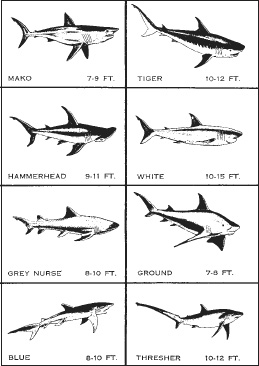
Sharks.
If bitten by a shark, the most important measure for you to take is to stop the bleeding quickly. Blood in the water attracts sharks. Get yourself or the victim into a raft or to shore as soon as possible. If in the water, form a circle around the victim (if not alone), and stop the bleeding with a tourniquet.
In salt water, other ferocious fish include the barracuda, sea bass, and moray eel. The sea bass is usually an open water fish. It is dangerous due to its large size. It can remove large pieces of flesh from a human. Barracudas and moray eels have been known to attack man and inflict vicious bites. Be careful to these two species when near reefs and in shallow water. Moray eels are very aggressive when disturbed.
In fresh water, piranha are the only significantly dangerous fish. They are inhabitants of the tropics and are restricted to northern South America. These fish are fairly small, about 5 to 7.5 centimeters, but they have very large teeth and travel in large schools. They can devour a 135-kilogram hog in minutes.
There are several species of venomous fish and invertebrates, all of which live in salt water. All of these are capable of injecting poisonous venom through spines located in their fins, tentacles, or bites. Their venoms cause intense pain and are potentially fatal. If injured by one of these fish or invertebrates, treat the injury as for snakebite.
FEROCIOUS FISH
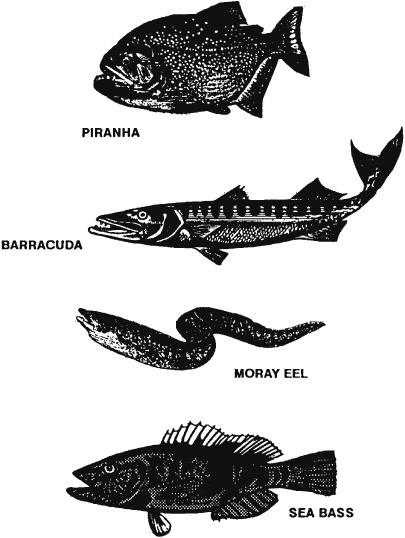
STINGRAYS
Dasyatidae species
Stingrays inhabit shallow water, especially in the tropics and in temperate regions as well. All have a distinctive ray shape but coloration may make them hard to spot unless they are swimming. The venomous, barbed spines in their talls can cause severe or fatal injury.
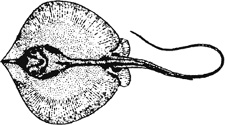
RABBITFISH
Siganidae species
Rabbitfish are found predominantly on reefs in the Pacific and Indian oceans. They average about 30 centimeters long and have very sharp spines in their fins. The spines are venomous and can inflict intense pain.
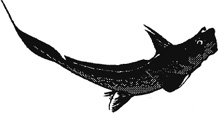
SCORPION FISH OR ZEBRA FISH
Scorpaenidae species
Scorpion fish or zebra fish live mainly in the reefs in the Pacific and Indian oceans. They vary from 30 to 90 centimeters long, are usually reddish in coloration, and have long, wavy fins and spines. They inflict an intensely painful sting.
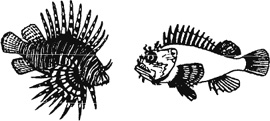
SIGANUS FISH
The siganus fish is small, about 10 to 15 centimeters long, and looks much like a small tuna. It has venomous spines in its dorsal and ventral fins. These spines can inflict painful stings.

STONEFISH
Synanceja species
Stonefish are found in the tropical waters of the Pacific and Indian oceans. Averaging about 30 centimeters in length, their subdued colors and lumpy shape provide them with exceptional camouflage. When stepped on, the fins in the dorsal spine inflict an extremely painful and sometimes fatal wound.

TANG OR SURGEONFISH
Acanthuridae species
Tang or surgeonfish average 20 to 25 centimeters in length, with a deep body, small mouth, and bright coloration. They have needlelike spines on the side of the tail that cause extremely painful wounds. This fish is found in all tropical waters.
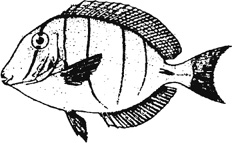
TOADFISH
Batrachoididae species
Toadfish are found in the tropical waters off the coasts of South and Central America. They are between 17.5 and 25 centimeters long and have a dull color and large mouths. They bury themselves in the sand and may be easily stepped on. They have very sharp, extremely poisonous spines on the dorsal fin (back).

WEEVER FISH
Trachinidae species
The weever fish is a tropical fish that is fairly slim and about 30 centimeters long. All its fins have venomous spines that cause a painful wound.

BLUE-RINGED OCTOPUS
Hapalochlaena lunulata
This small octopus is usually found on the Great Barrier Reef off eastern Australia. It is grayish-white with iridescent blue ringlike markings. This octopus usually will not bite unless stepped on or handled. Its bite is extremely poisonous and frequently lethal.
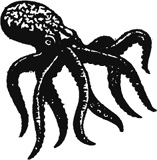
JELLYFISH
Jellyfish-related deaths are rare, but the sting they inflict is extremely painful. The Portuguese man-of-war resembles a large pink or purple balloon floating on the sea. It has poisonous tentacles hanging up to 12 meters below its body. The huge tentacles are actually colonies of stinging cells. Most known deaths from jellyfish are attributed to the man-of-war. Other jellyfish can inflict very painful stings as well. Avoid the long tentacles of any jellyfish, even those washed up on the beach and apparently dead.
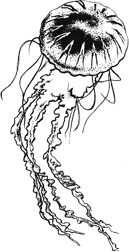
Venomous sea snakes are not found in the Atlantic, but occur in large numbers off the shores of the Indian Ocean and the southern and western Pacific. They usually are encountered in tidal rivers and near the coast but may be seen far out at sea. They do not disturb swimmers, so there is little danger of being bitten. They are identified by their flat, vertically compressed paddle tail.
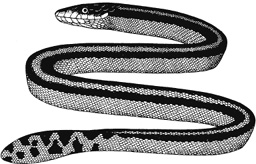
CONE SHELLS
Conidae species
These cone-shaped shells have smooth, colorful mottling and long, narrow openings in the base of the shell. They live under rocks, in crevices or coral reefs, and along rocky shores of protected bays in tropical areas. All have tiny teeth that are similar to hypodermic needles. They can inject an extremely poisonous venom that acts very swiftly, causing acute pain, swelling, paralysis, blindness, and possible death within hours. Avoid handling all cone shells.

TEREBRA SHELLS
Terebridae species
These shells are found in both temperate and tropical waters. They are similar to cone shells but much thinner and longer. They poison in the same way as cone shells, but the venom is not as poisonous.

Dangerous water animals listed above by no means exhaust the list of hazards you may encounter. Tropical bone shell and long, slender, pointed terebra snails are also poisonous. Handle big conchs with caution; large abalones and clams can be dangerous if gathered by hand instead of pried loose with a bar or wedge. They may clamp onto your fingers and hold you under until you drown. Coral, dead or alive, can inflict painful cuts; seemingly harmless sponges and sea urchins can slip fine needles of lime or silica into your skin, which will break off and fester.
SHELLS AND CORAL
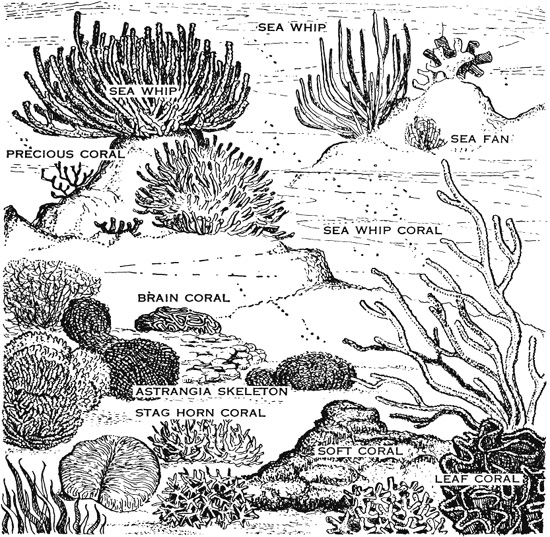
U.S. Army
You recognize and identify insects, except centipedes and millipedes, by their six legs while arachnids have eight. All these small creatures become pests when they bite, sting, or irritate you.
Although their venom can be quite painful, bee, wasp, and hornet stings rarely kill a survivor unless he is allergic to that particular toxin. Even the most dangerous spiders rarely kill, and the effects of tick-borne diseases are very slow-acting. However, in all cases, avoidance is the best defense. In environments known to have spiders and scorpions, check your footgear and clothing every morning. Also check your bedding and shelter for them. Use care when turning over rocks and logs. See Appendix D for examples of dangerous insects and arachnids.
You find scorpions (Buthotus species) in deserts, jungles, and forests of tropical, subtropical, and warm temperate areas of the world. They are mostly nocturnal in habit. You can find desert scorpions from below sea level in Death Valley to elevations as high as 3,600 meters in the Andes. Typically brown or black in moist areas, they may be yellow or light green in the desert. Their average size is about 2.5 centimeters. However, there are 20-centimeter giants in the jungles of Central America, New Guinea, and southern Africa. Fatalities from scorpion stings are rare, but they can occur in children, the elderly, and ill persons. Scorpions resemble small lobsters with raised, jointed tails bearing a stinger in the tip. Nature mimics the scorpions with whip scorpions or vinegarroons. These are harmless and have a tail like a wire or whip, rather than the jointed tail and stinger of true scorpions.
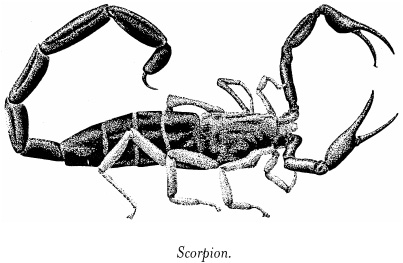
You recognize the brown recluse or fiddleback spider of North America (Loxosceles reclusa) by a prominent violin-shaped light spot on the back of its body. As its name suggests, this spider likes to hide in dark places. Though rarely fatal, its bite causes excessive tissue degeneration around the wound and can even lead to amputation of the digits if left untreated.
You find members of the widow family (Latrodectus species) worldwide, though the black widow of North America is perhaps the most well-known. Found in warmer areas of the world, the widows are small, dark spiders with often hourglass-shaped white, red, or orange spots on their abdomens.
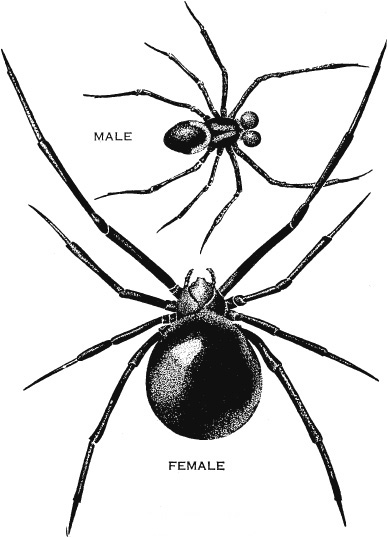
Black widow spider.
Funnelwebs (Atrax species) are large, gray or brown Australian spiders. Chunky, with short legs, they are able to move easily up and down the cone-shaped webs from which they get their name. The local populace considers them deadly. Avoid them as they move about, usually at night, in search of prey. Symptoms of their bite are similar to those of the widow’s—severe pain accompanied by sweating and shivering, weakness, and disabling episodes that can last a week.
Tarantulas are large, hairy spiders (Theraphosidae and Lycosa species) best known because they are often sold in pet stores. There is one species in Europe, but most come from tropical America. Some South American species do inject a dangerous toxin, but most simply produce a painful bite. Some tarantulas can be as large as a dinner plate. They all have large fangs for capturing food such as birds, mice, and lizards. If bitten by a tarantula, pain and bleeding are certain, and infection is likely.
Centipedes and millipedes are mostly small and harmless, although some tropical and desert species may reach 25 centimeters. A few varieties of centipedes have a poisonous bite, but infection is the greatest danger, as their sharp claws dig in and puncture the skin. To prevent skin punctures, brush them off in the direction they are traveling, if you find them crawling on your skin.
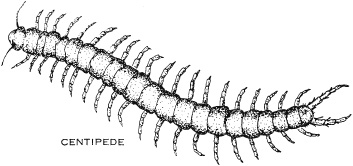
We are all familiar with bees, wasps, and hornets. They come in many varieties and have a wide diversity of habits and habitats. You recognize bees by their hairy and usually thick body, while the wasps, hornets, and yellow jackets have more slender, nearly hairless, bodies. Some bees, such as honeybees, live in colonies. They may be either domesticated or living wild in caves or hollow trees. You may find other bees, such as carpenter bees, in individual nest holes in wood, or in the ground, like bumblebees. The main danger from bees is their barbed stinger located on their abdomens. When the bee stings you, it rips its stinger out of its abdomen along with the venom sac, and the bee dies. Except for killer bees, most bees tend to be more docile than wasps, hornets, and yellow jackets that have smooth stingers and are capable of repeated attacks.
Avoidance is the best tactic for self-protection. Watch out for flowers or fruit where bees may be feeding. Be careful of meat-eating yellow jackets when cleaning fish or game. The average person has a relatively minor and temporary reaction to bee stings and recovers in a couple of hours when the pain and headache go away.
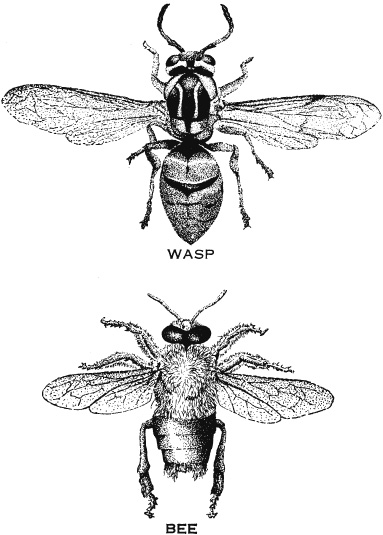
Those who are allergic to bee venom have severe reactions including anaphylactic shock, coma, and death. If antihistamine medicine is not available and you cannot find a substitute, an allergy sufferer in a survival situation is in grave danger.
Ticks are common in the tropics and temperate regions. They are familiar to most of us. Ticks are small round arachnids with eight legs and can have either a soft or hard body. Ticks require a blood host to survive and reproduce. This makes them dangerous because they spread diseases like Lyme disease and Rocky Mountain spotted fever.
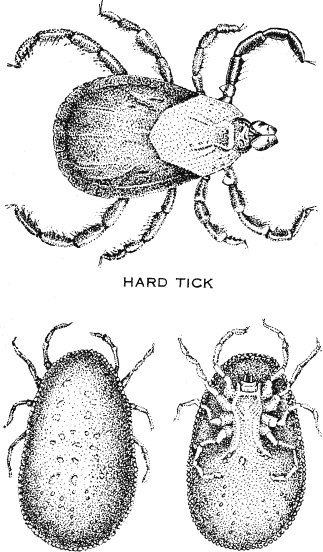
—From Survival (Field Manual 21–76)
Lang Elliott
The majority of night-active insect soundmakers belong to the order Orthoptera, which includes the crickets, grasshoppers, and katydids. In these groups, breeding males produce calls with specialized “stridulating” organs located on their wings. These consist of a “file and scraper” mechanism that is used to produce chirps, trills, and grating chatters. Other insect groups also produce sounds, but these may have little to do with breeding. For instance, the bark-eating grubs of certain long-horned beetles produce distinctive chewing sounds as they feed, both day and night.
About ¾ inch long. Pale-green cricket with delicate, lacy wings and long antennae. Stridulating male produces melodic chirps from shrubs, often near the ground. He raises his wings straight up when singing and exposes a gland that secretes a glutinous liquid that the female devours prior to copulation. Often referred to as “temperature cricket” because the number of chirps occurring in 15 seconds plus 40 yields a close approximation of the temperature in Fahrenheit.
About 1 inch long. An odd-looking, burrowing cricket with enlarged forelegs adapted for digging. Common throughout most of the East in muddy areas along shorelines or in other wet areas. Male chirps from entrance to his burrow. The song of this species is the lowest-pitched of all our native insect breeding calls.
A member of the subfamily Nemobiinae which includes a variety of different ground crickets. About ½ inch long and brownish-black in color. Ranges across most of the Unites States. Sings from the ground in pastures, lawns, and moist ditches. The song of the male is a high-pitched buzzing trill that often has a pulsating or jerky quality.
About 1½ to 2 inches long; dark green with gauze-like wings and long antennae. Katydids are members of the Long-horned Grasshopper family (Tettigoniidae), named for their long antennae. The Northern True Katydid is common throughout most of the East. Male’s harsh call sounds like ch-ch or ch-ch-ch, given about once every second with rhythm of words ka-ty or ka-ty-did. Neighboring individuals and large choruses sometimes call in almost perfect unison.
Another member of the Long-horned Grasshopper family. About 2 inches long. Slender and green, with long antennae and conical head. Commonly found in tall grass or weeds in the Northeast and upper Midwest, often along roads and highways. Song is composed of very high-pitched, lispy notes given in rapid succession.
Member of Cerambycidae, the Long-horned Beetle family. Adults about 1 inch long, elongated, with long antennae. Larvae of certain species, such as Monochamus notatus, the Northeastern Sawyer, bore into the trunks of dead or dying pines to feed on the inner bark, hence the name “Pine Sawyer.” Larvae are white grubs with dark mouthparts; they grow to about 1¾ inch long. Pine Sawyer larvae make scraping and chewing noises when feeding. These sounds can be heard over 100 feet away on a quiet night.
—From A Guide to Night Sounds